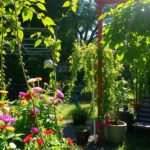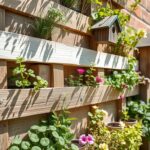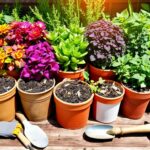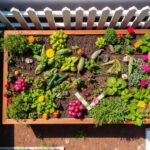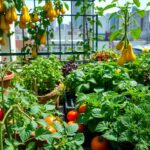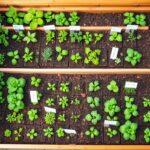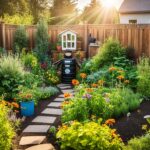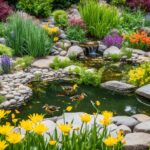glenn.imagepros
How to Optimize Sunlight in Small Gardens: Tips for Better Plant Growth
Are you finding it tough to grow healthy plants in a small garden? The key might be in making the most of the sunlight. Even with limited sunlight, there are smart ways to help your garden flourish. Learn how to make the most of sunlight in your small garden and bring your green space to life.
Key Takeaways
- Leverage reflective surfaces to bounce sunlight into shaded areas
- Strategically position plants to capture maximum light exposure
- Utilize mirrors and water features to amplify natural lighting
- Manage your trees and shrubs to allow more sunlight to reach the ground
- Embrace shade-loving plants to thrive in darker corners
Reflecting Sunlight with White Surfaces
Using white surfaces is a great way to make your small garden brighter. Painting walls, sheds, and other structures in white can reflect sunlight. This helps plants nearby get more light. Also, choosing light-colored paving like warm honey-colored pavers can improve light reflection. This is better than using dark materials like slate or grey concrete.
Paint Garden Walls and Structures White
A fresh coat of white or pale paint can change your garden for the better. These colors reflect sunlight, making your garden feel brighter and more welcoming. Think about painting your garden walls, fences, sheds, or trellises white for a clean look.
Choose Light-Colored Paving Materials
For your garden paths or patio, pick light-colored paving like sandstone, limestone, or light-colored concrete. These white surfaces reflect more sunlight than dark pavers. This makes your outdoor space brighter and more lively.
“Maximizing the use of white surfaces and light-colored paving can dramatically enhance the overall brightness and ambiance of your small garden.”
Brightening Shady Areas with Plants
In your small garden, picking the right plants can make shady spots brighter. Use white flowers and plants with variegated leaves to make it seem like there’s more light. This creates a welcoming feel.
Using White Flowers and Variegated Foliage
White flowers are great for making shady corners bright. As the sun goes down, they glow, making the area look more inviting. Plants with variegated leaves also help spread and brighten the little sunlight there is. This makes the space feel bigger and more open.
- Choose white-flowering plants like Hydrangea, Impatiens, or Camellia for a bright look.
- Add plants with variegated leaves such as Heuchera, Brunnera, or Pulmonaria to brighten shady spots even more.
By placing these plants thoughtfully in your garden, you can turn dark spots into bright, lively areas. The mix of white flowers and variegated leaves will brighten shady areas. This makes your garden more welcoming and beautiful.
“Embrace the power of light-reflecting plants to transform your small garden’s shady nooks into welcoming, luminous havens.”
Maximize Light with Mirrors
Using garden mirrors in your small outdoor area is a great way to make it look bigger and brighter. Place a mirror in the sunniest part of your garden and angle it towards the shadows. This trick can make your garden seem more open and bright, perfect for your plants and reflective surfaces.
But, be careful with mirrors in the garden. Don’t use mirrors that can magnify the sun or point several mirrors at one spot. This could start a fire.
- Pick lightweight, shatter-resistant mirrors made for the outdoors to stay safe and last longer.
- Put the mirror where it gets the most sunlight during the day.
- Angle the mirror to send light into the shady parts of your garden.
- Try different mirror sizes and spots to maximize light and add beauty.
By using mirrors smartly, you can turn your small garden into a bright, inviting place. It will highlight your plants and make the area feel more welcoming. Always think about safety and enjoy how mirrors play with light and reflection.
| Mirror Type | Advantages | Considerations |
|---|---|---|
| Convex Mirrors | Offer a wider field of view, creating the illusion of a larger space | May distort the reflection and should be used with caution |
| Flat Mirrors | Provide a more accurate reflection without distortion | Offer a more limited field of view compared to convex mirrors |
| Mirrored Tiles | Can be arranged in various patterns to reflect light in unique ways | Require careful planning and installation to achieve the desired effect |
“Mirrors have the power to transform a space, reflecting light and creating the illusion of depth and openness. In a small garden, they can be a valuable tool to maximize light and enhance the overall sense of spaciousness.”
Utilize Water Features for Reflections
Adding a water feature like a pond or fountain can brighten up your small garden. These elements are great at reflecting light. They make your outdoor space look beautiful and change with the light.
A water feature can turn your garden into a stunning spot. The reflections of sunlight move across the water, making your garden warm and welcoming. Whether it’s a fountain or a pond, these features spread light around your garden. They make your space look better and more inviting.
- Place your water feature where it catches the most sunlight for the best light effect.
- Think about adding moving parts like fountains or waterfalls to make your reflections more interesting.
- Use light-colored stones or tiles for your water feature to make it reflect even more light.
Using water features to reflect light can make your small garden a bright and enchanting place. The moving reflections will catch your eye and make you feel happy.
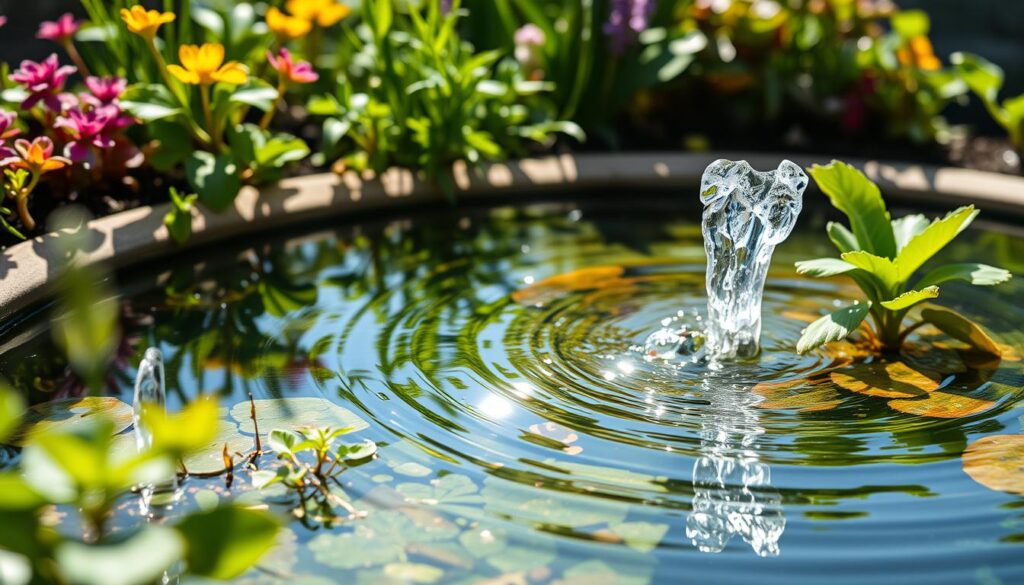
Install Glass Garden Sculptures
Adding glass garden sculptures can make your small outdoor space more interesting all year. These sculptures reflect light and spread it in unique ways. This makes your garden look more magical.
Precautions with Glass Sculptures
When you put glass art in your garden, think about the risks. Things like tree branches or bad weather can damage them. Check your glass garden sculptures often to keep them safe and lasting longer.
- Think about where you put your sculptures. Stay away from areas with falling branches or lots of people walking by.
- Check your sculptures for any damage or wear. Fix any problems right away.
- Think about using strong mounts or shields to protect your reflective surfaces from harm.
By carefully adding glass garden sculptures and being cautious, you can make a beautiful and safe outdoor space. This space will show off the beauty of glass art and how reflection works.
Optimize sunlight in small gardens through Tree Management
If a big tree is blocking sunlight from your small garden, don’t worry. You don’t have to cut down the tree. Instead, try tree management methods that let in more sunlight without harming the tree or your garden.
Crown Thinning for More Light
Crown thinning is a great way to get more sunlight. It means removing dead, damaged, or crowded branches. This way, up to 30% more sunlight can get through, keeping the tree’s shape and size intact. It’s a gentle method that keeps the tree looking good and brightens your garden.
Canopy Reduction for Overgrown Trees
For trees that are too big and block too much sunlight, a canopy reduction can help. A professional will trim the tree’s canopy to let more sunlight in. This keeps the tree but lets your garden get the light it needs to grow well.
Using these tree management techniques, you can make your small garden brighter without losing the beauty of your trees. Try crown thinning and canopy reduction for a sunny, lively outdoor space.
Embrace Shade-Loving Plants
If your small garden doesn’t get much sunlight, don’t worry. There’s a world of shade-loving plants that do well in low light. These plants can make your garden look lush and beautiful, even in the shade. The trick is to pick the right plant selection for low-light gardening.
The Royal Horticultural Society’s website is a great place to find plants that love shade. You can discover plants like the elegant Japanese Painted Fern and the charming Bleeding Heart. These plants can turn a dark corner into a lively spot. By choosing shade-loving plants, you can make your garden feel peaceful and inviting, even without lots of sunlight.
- Japanese Painted Fern
- Bleeding Heart
- Hostas
- Astilbes
- Hellebores
With some research and an eye for the right plants, you can make a beautiful shade-loving garden. These plants can make your small space look stunning and inviting. Embrace the beauty of these plants to create a lush retreat, even in the shadiest spots.
“The key to a successful shade garden is choosing the right plants that not only tolerate low-light conditions but also add visual interest and depth to the space.”
Strategically Position Plants for Maximum Light
In a small garden, where every inch counts, where you place your plants is key. By placing them smartly, you can make sure the sun-loving plants get enough light. This also helps create beautiful arrangements.
Utilize Window Sills and Shelves
Use your space wisely with window sills and plant shelves or stands. These options let you grow many plants, even those that love bright light. Put your tallest or sun-loving plants near windows to catch the most sunlight all day.
- Use window sills for small, bright plants.
- Install shelves or stands near windows for multi-level plants.
- Arrange plant shelves smartly to use window sills and vertical gardening well.
By thoughtfully positioning your plants, you can get more sunlight to them. This leads to healthier plants and a lively small garden.
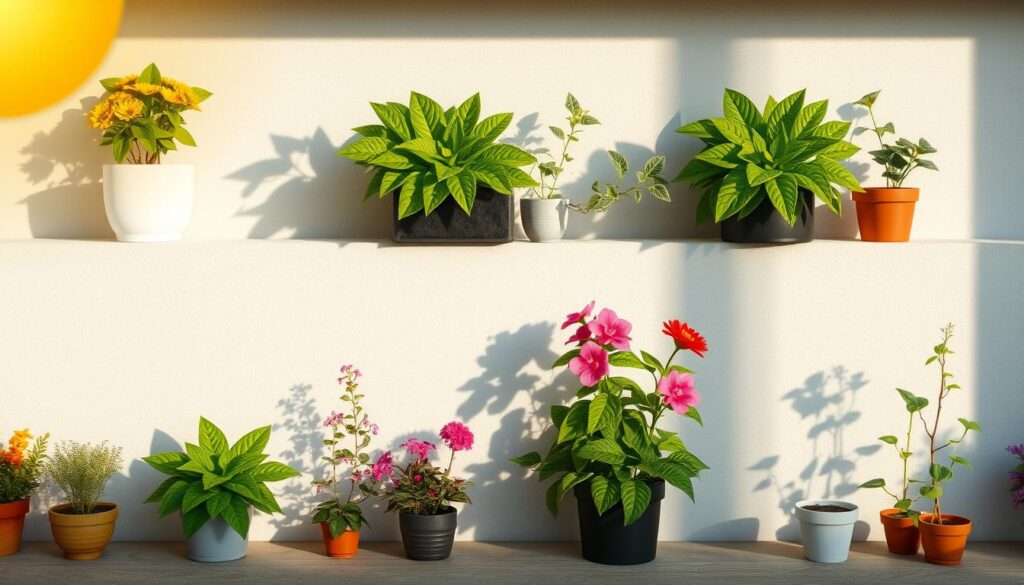
“In a small garden, every inch of available space is precious. Utilize window sills and shelves to create a vertically-stacked plant paradise that thrives in the optimal sunlight.”
Consider Hanging Pendant Grow Lights
If your small garden lacks enough natural light, a hanging pendant grow light might be the answer. These lights are better than traditional ones because they look good and don’t give off a bad purple light. They fit well with your indoor decor and give your plants the extra light they need.
There are many sizes and styles of hanging pendant grow lights to pick from. You can find one that matches your indoor gardening setup perfectly. Whether you like a modern white or a bold black look, these lights will enhance your space while helping your plants grow.
| Feature | Benefit |
|---|---|
| Warm-white light spectrum | Promotes healthy plant growth |
| Adjustable hanging height | Customizable for different plant types |
| Long-lasting LED technology | Efficient and energy-saving |
| 5-year warranty | Reliability and peace of mind |
Adding a hanging pendant grow light to your small garden makes sure your plants get enough supplemental lighting. It also keeps your indoor space looking good and put together.
“Investing in a high-quality hanging pendant grow light has been a game-changer for my indoor garden. It provides the perfect balance of functionality and style.”
Seasonal Adjustments for Optimal Sunlight
Getting the right amount of sunlight in your small garden takes careful attention to seasonal changes. The sun moves throughout the year, so you must adjust to keep your plants well-lit. Knowing your garden’s micro-climate helps you fine-tune your sunlight strategy.
In spring, the sun is lower and you can place plants in the shade. As summer comes, move plants to get more sunlight. In autumn, when the sun goes down earlier, put some plants in sunnier spots.
- Watch how the sun moves and changes in your garden to spot seasonal shifts in sunlight.
- Try different plant positions to make sure all plants get enough sun.
- Keep an eye on your garden’s layout to match the changing sunlight patterns.
By paying attention to seasonal sun exposure and making adjustments, you can create the best lighting for your plants all year.
“The secret to a vibrant, healthy garden lies in understanding and adapting to the ever-changing sunlight patterns in your small outdoor space.”
Conclusion
Optimizing sunlight is key for small gardens to grow well and look great. Use white surfaces, mirrors, and water features to reflect light. Also, manage your trees to let more sunlight in.
Every garden is different, so try various methods to find what works best. Use plants that love shade and place your plants smartly to get the most light. With creativity and hard work, your small garden can be beautiful and support plant growth.
Optimizing sunlight in small gardens is a fun challenge. Let your imagination run wild and see your garden become a lush haven. It’s a great way to make your outdoor space better and bring happiness into your life.
FAQ
How can I use white surfaces to reflect more sunlight in my small garden?
Painting walls, sheds, or pergolas in white or cream can reflect sunlight. This helps plants nearby. Also, using light-colored paving like warm honey-colored pavers can reflect more light than dark options like slate or grey concrete.
What types of plants can help brighten up shady areas in my small garden?
White flowers and plants with variegated leaves can brighten shady spots. White flowers stand out at dusk. Variegated leaves reflect and spread light, making areas feel brighter.
How can I use mirrors to increase the amount of light in my small garden?
Mirrors can increase light in your garden. Place a mirror in a bright spot and angle it towards dark areas. This spreads light and makes your garden seem bigger and brighter. But, avoid using mirrors that magnify or point to the same spot to prevent fire hazards.
What are the benefits of incorporating a water feature in my small garden?
A water feature like a pond or fountain can brighten your garden. Water reflects light in changing ways, spreading it around. A well-designed water feature can be a focal point, making your garden more luminous and appealing.
What precautions should I take when installing glass garden sculptures?
Be careful with glass sculptures. Check for tree branches that could fall and break the glass in bad weather. Keep the sculptures safe by regular checks and maintenance.
How can I optimize sunlight in my small garden if I have a large tree blocking the light?
You don’t have to cut down a big tree to get more sunlight. Try thinning the tree’s crown or reducing its canopy. This lets up to 30% more light in while keeping the tree’s shape and size.
For big, overgrown trees, a professional can reduce the canopy. This increases sunlight in your garden.
What are some shade-loving plants that can thrive in my small garden with limited sunlight?
The Royal Horticultural Society website has lots of info on plants for shady spots. You can create a lush garden even with little sunshine.
How can I strategically position my plants to maximize sunlight exposure in my small garden?
Where you put your plants is key to getting more sunlight. Put tall or sun-loving plants near windows for the most light. Use window sills and plant shelves to grow more plants in your small space.
What type of supplemental lighting can I use in my small garden if it struggles with insufficient natural light?
A hanging pendant grow light can help if your garden lacks natural light. These lights are nice-looking and don’t ruin your decor. They give your plants the extra light they need without making your garden look bad.
How should I adjust my small garden layout to accommodate seasonal changes in sunlight exposure?
Sunlight changes with the seasons. Watch how the sun moves and adjust your garden as needed. Move plants or change your garden layout to make sure your plants get enough light all year.
Understanding your garden’s micro-climate helps you get the most sunlight.
Source Links
- 7 Ways to Get More Light Into Your Garden – Climbers Way Tree Care – https://climberswaytreecare.co.uk/7-ways-get-light-garden/
- Growing a Sustainable Garden: The Best Plants for a Greener Future – Zero Waste Kitchen – https://zerowastekitchen.moveforhunger.org/growing-a-sustainable-garden-the-best-plants-for-a-greener-future/
- 4 Easy Tricks To Increase Your Light For Plants That May Save You From – https://www.geturbanleaf.com/blogs/growing-your-urban-leaf-garden/improve-light-for-plants?srsltid=AfmBOooq5mKTWRHAepexdh8LtwGixTtVzSW2YBiGtu-JkvCqdpObnaCe
DIY Vertical Planters: Creative Ideas for Small Space Gardening
Do you dream of having a lush garden but don’t have much space? DIY vertical planters can change that! They’re perfect for small balconies, cozy patios, or even indoor spots. With these smart solutions, you can grow a beautiful garden right at home.
Learn how to make the most of your space and bring nature indoors. These planters are not just for plants; they’re a way to make your home look and feel better.
Key Takeaways
- Vertical gardening optimizes limited spaces for maximum greenery
- DIY vertical planters are affordable and customizable
- Vertical gardens improve air quality and add aesthetic appeal
- Repurposed materials and clever designs make vertical gardening accessible
- Discover a variety of DIY vertical planter ideas to suit your unique space
Benefits of Vertical Gardening
Vertical gardening brings many advantages to your living space. It uses the vertical space to make even small areas into lush gardens. This way, you can enjoy space optimization and make the most of every inch.
Plants in a vertical garden look great and improve aesthetic appeal. They also help make the air cleaner, boosting improved air quality indoors or outdoors.
Space Optimization
Vertical gardening lets you use space wisely, even in tight spots like balconies or narrow yards. You can grow many plants in a small area, making the most of your space.
Improved Air Quality
Plants clean the air by taking in carbon dioxide and giving off oxygen. A vertical garden creates a space that improves air quality. It also supports biodiversity, making the air healthier.
Aesthetic Appeal
Vertical gardens turn dull spaces into beautiful spots. They add life with their greenery, textures, and colors. This makes your indoor or outdoor areas look stunning and welcoming.
Vertical gardening offers many benefits, like better temperature regulation and noise reduction. It also means easy maintenance and enhanced privacy. Let your small space flourish with a vertical garden.
Getting Started with DIY Vertical Planters
Starting a DIY vertical planter project is fun and rewarding. It lets you make a green and beautiful part of your home. If you have a small balcony, patio, or a tight corner, vertical gardening is a great way to use your space well.
Essential Supplies
To start your vertical planter, you’ll need some key items. You’ll need a strong vertical support like a wall mount, a freestanding unit, or something you can reuse like a ladder or shelves. You’ll also need good planters, potting soil, and plants that do well in your area. Don’t forget gardening tools, a watering system, and hardware to hold your garden up.
Repurposing Materials
One of the best parts of DIY vertical gardening is using old items in new ways. Think about using pallets, old fences, window frames, or a bed frame for your planter. These repurposed materials can save you money and make your project more affordable DIY. They also help with sustainable gardening.
By choosing the right essential supplies and using upcycling, you can turn a small space into a lively, vertical garden. It will show off your style and support sustainable living.
Pallet Vertical Gardens
Turning wooden pallets into vertical gardens is a smart way to use space and add rustic charm to your yard. These pallet vertical gardens are great for growing plants, herbs, and small vegetables. They help you use every inch of your space.
Pallets are very versatile for vertical gardening. You can use them as-is, with the gaps for plants. Or, you can upcycle them to make custom vertical gardens. You can use things like tin cans, window boxes, or hanging baskets. This lets you create your own DIY garden projects.
To start, pick a strong pallet and plan how you’ll arrange your plants. You can keep the pallet whole or take it apart for a freestanding garden. Make sure the pallet is clean and ready for your plants before you begin.
“Vertical gardening using pallets is a fantastic way to transform even the smallest of spaces into a lush, thriving oasis.”
After setting up your pallet garden, you can have fun with different plants. Try vines, flowers, herbs, and small vegetables. This way, you make the most of your space and add beauty to your yard.
Pallet vertical gardens are great for gardeners at any level. They’re easy on the wallet and help you save space. So, get creative with upcycled materials and start your DIY garden project today. Watch your garden grow and flourish.
DIY Trellis and Lattice Gardens
Boost your small-space gardening with DIY trellis and lattice structures. These vertical solutions increase your growing area and add beauty to your outdoor space.
DIY Trellis Garden
A simple trellis with evenly spaced slats is great for climbing plants. Use materials like wood, metal, or repurposed items. Arrange the slats for a sturdy framework that supports your garden.
Lattice Succulent Garden
For a modern look, try a DIY lattice system with your succulents. The open grid lets you hang potted succulents or create a cascading display. Choose lattice patterns and materials that match your outdoor space and succulent plants.
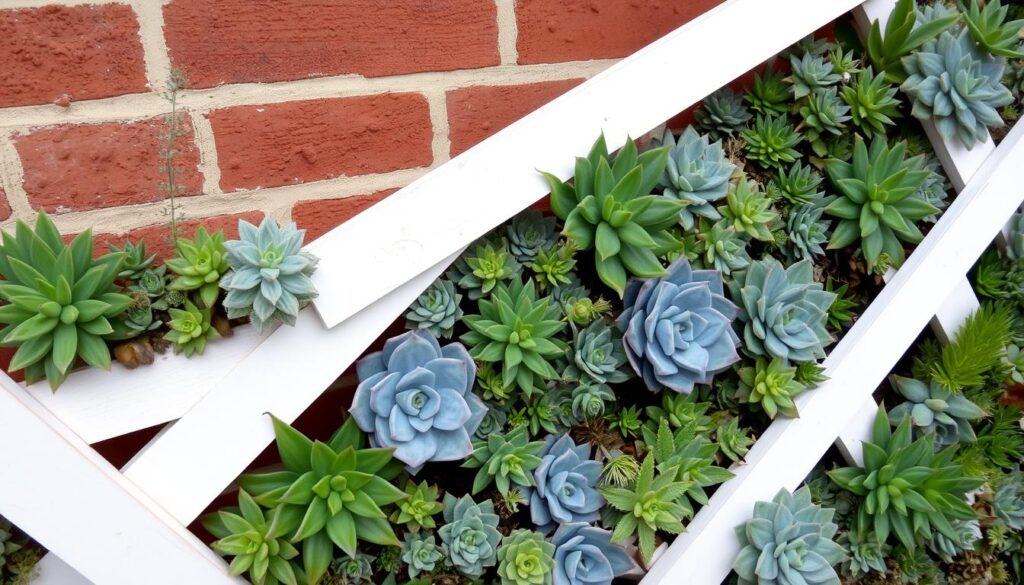
Choosing a classic trellis or a lattice can turn small spaces into lush gardens. With creativity and effort, you can create a beautiful, space-saving oasis in your backyard.
Wall-Mounted Vertical Gardens
If you live in a small space without fences or standalone gardens, wall-mounted vertical gardens can change everything. These solutions let you use your walls to grow plants. They turn bare walls into green spaces.
Hanging Pots and Planters
Use special hangers or wires to hang pots and planters on your wall. This makes it seem like your plants are floating. It saves floor space and adds charm to your garden. Try different plants like vines or succulents for a unique look.
Floating Shelves and Window Boxes
Attach floating shelves to your wall for a tiered garden. They let you show off your plants. For outside walls, use window boxes to grow plants. This brings nature right to your doorstep.
| Vertical Gardening Method | Benefits |
|---|---|
| Hanging Pots and Planters | Saves floor space, adds visual interest |
| Floating Shelves | Creates a tiered vertical garden, showcases plants |
| Window Boxes | Brings nature to exterior walls and fences |
Choose hanging pots, floating shelves, or window boxes for your wall garden. These options are great for vertical gardening in small spaces. With creativity, you can make your walls into beautiful gardens. They add beauty and help the environment at home.
Freestanding Vertical Gardens
If you don’t have a wall or fence for a vertical garden, you can make a freestanding one. You can choose from elegant arbor gardens or DIY ladder vertical gardens. These options let you enjoy vertical gardening even without walls or fences.
Arbor Garden
Turn an arbor into a lush vertical garden. Add wire screening or trellises for a strong support for hanging planters or vines. This design fits your space and style, making a beautiful spot in your garden.
DIY Ladder Vertical Garden
Build a unique ladder vertical garden for a mobile solution. Use an old ladder or make a new one, then add containers or baskets at different levels. This design lets you move your garden easily, perfect for small spaces indoors or outdoors.
“Vertical gardening is a game-changer for those with limited square footage, allowing you to cultivate a thriving oasis in even the smallest of spaces.”
| Freestanding Vertical Garden Type | Benefits | Considerations |
|---|---|---|
| Arbor Garden |
|
|
| DIY Ladder Vertical Garden |
|
|
DIY vertical planters
If you’re short on gardening space, don’t worry. DIY vertical planters can help. They let you use ordinary items in new ways, making your space-saving garden unique. You can turn everyday containers into planters or build your own garden frames. This way, even small spaces can have a lush, green oasis.
Upcycling is key to DIY vertical planters. It lets you use your creativity and love for DIY. You can take an old boot, picture frame, or plastic bottle and make it into a planter. This not only looks great but is also good for the planet.
Repurposing Everyday Items
- Turn a pair of rain boots into a charming vertical planter
- Upcycle a wooden crate or pallet into a rustic vertical garden
- Breathe new life into a discarded ladder with a DIY ladder planter
- Craft a unique vertical garden using recycled plastic bottles or tin cans
Building Your Own Vertical Planter Frames
You can also build your own vertical planter frames. This lets you match the size and style to your space and taste. With simple tools and creativity, you can make a vertical garden that shows off your style.
No matter your skill level or materials, DIY vertical planters can change small spaces into beautiful gardens. So, why not show off your gardening skills with upcycled containers and custom frames?
Creative Vertical Garden Ideas
Vertical gardening lets you get creative and make your space unique. You can use old boots or make your own planters. Let’s look at some ideas that turn small spaces into beautiful gardens.
Boot Planters
Using old boots as planters is a fun and unique idea. Hang them on a fence or wall and fill them with plants or succulents. It’s a way to reuse items and add charm to your garden.
Framed Succulent Garden
For a modern look, try a framed succulent garden. Put small succulents in a wooden or metal frame. Then, hang it on a wall or fence. The design and textures of the succulents are fascinating.
Monogram Planter
Make your garden personal with a monogram planter. Build a frame with your initial or family name. Fill it with vines, flowers, or herbs. It’s a creative way to show off your gardening skills and style.
These ideas show how you can turn small spaces into beautiful gardens. By using everyday items and adding your personal touch, you can make gardens that are both beautiful and functional.
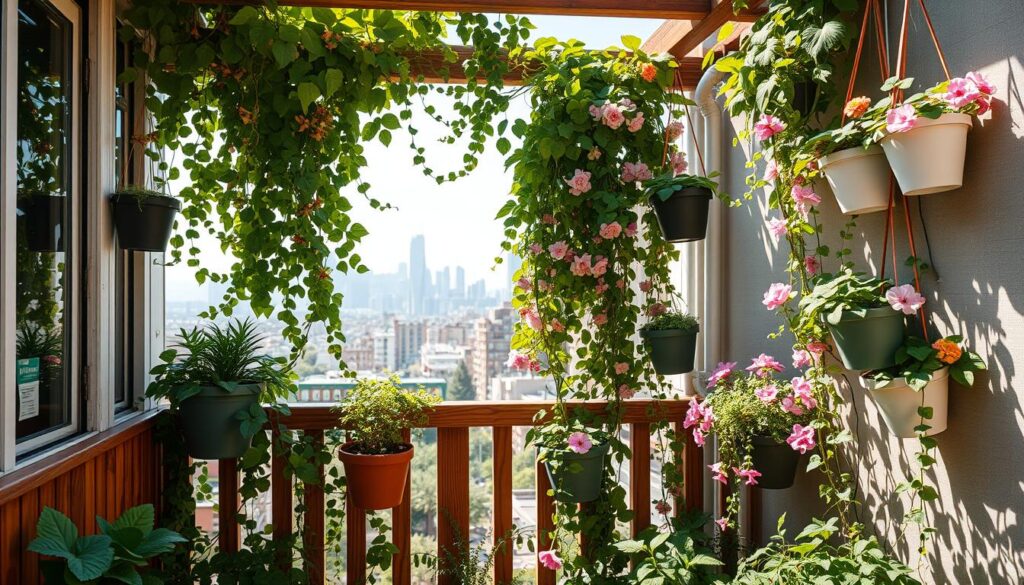
Conclusion
Vertical gardening has changed how we garden in small spaces. It brings many benefits and creative ideas. By using DIY vertical planters and old materials, you can make even tiny spaces into a lush garden. This garden can make your living area better and feed your gardening passion.
Looking to use your space better, improve air quality, or add beauty to your area? Vertical gardening is the answer. You can choose from pallet gardens, wall planters, or freestanding setups. This lets you make your garden unique to your style and tastes.
Starting your vertical gardening adventure means being open to trying new things, using old materials, and being creative. With some inspiration and DIY skills, you can make a garden that’s not just pretty. It also connects you to nature and brings joy from gardening in small spaces. Try vertical gardening and see what you can do with your small space today.
FAQ
What are the benefits of vertical gardening?
Vertical gardening uses space well, great for small homes. It boosts air quality, keeps temperatures steady, and reduces heat. Plus, it makes your space look better and helps nature.
What supplies do I need to start a DIY vertical planter project?
You’ll need a vertical support, planters, good soil, plants, and gardening tools. Don’t forget a watering system and hardware for building. Using second-hand items adds a personal touch and helps the planet.
How can I use pallets to create a DIY vertical garden?
Pallets work great as-is for planting. Or, use them to hold planters like tin cans or big window boxes. You can also take apart pallets to make your own vertical garden or living walls.
What are some other DIY vertical planter ideas?
There are many ways to make your own vertical garden. You can use things like boots, picture frames, and pop bottles as planters. Or, build your own boxes or frames for a unique garden.
How can I create a wall-mounted vertical garden?
Hang pots and planters from the wall with special hangers or wires. Floating shelves can also hold plants. Window boxes are great for growing plants on walls or fences outside.
Source Links
- 60 DIY Vertical Garden Ideas for Small Spaces – https://www.prudentpennypincher.com/vertical-garden-ideas-for-small-spaces/
- DIY Vertical Garden Ideas (For More Growing Space In Small Gardens) – https://www.fromhousetohome.com/garden/diy-vertical-garden-ideas/
- A Complete Guide to Vertical Gardening (On a Budget!) – https://rootsandrefuge.com/vertical-gardening-on-a-budget/
Companion Planting for Small Vegetable Gardens: Boost Growth and Deter Pests
Ever thought about making your small garden a place of growth and balance? Companion planting is the key to unlocking your garden’s full potential. It’s an old trick that pairs plants together to fight pests and boost health.
But what makes this method work? How can you use it to make your garden thrive with little effort? Let’s dive into the world of companion planting for small gardens and find out.
Key Takeaways
- Companion planting is the strategic pairing of plants to create mutually beneficial relationships in your garden.
- This technique can deter pests, attract beneficial insects, improve soil fertility, and increase overall plant yields.
- Companion planting is especially valuable for small gardens, where space is limited, and every square inch counts.
- By understanding the unique properties and interactions of different plants, you can cultivate a thriving, low-maintenance garden.
- Companion planting is a key strategy in organic and sustainable gardening practices, allowing you to grow a bountiful harvest while minimizing the use of harmful chemicals.
What is Companion Planting?
Companion planting is a way to grow different plants together. It uses the natural interactions between plants to help each other. This makes your vegetable garden healthier and more productive.
The idea behind companion planting is simple. Some plants help others by fighting pests, making soil better, or growing together well. This can be one-way, where one plant helps another. Or it can be like the Three Sisters method, where corn, beans, and squash help each other grow.
The Benefits of Companion Planting
Pairing plants can bring many benefits. Here are some:
- Deterring pests: Mixing crops makes it hard for pests to find their favorite plants.
- Attracting beneficial insects: Some plants draw in insects that eat garden pests, controlling them naturally.
- Regulating shade and support: Taller plants can shade and support shorter ones.
- Improving soil fertility: Some plants fix nitrogen or loosen hard soil, helping their neighbors.
- Suppressing weeds: Plants grown close together can block weeds, cutting down on weeding.
Adding companion plants to your vegetable garden boosts its health and productivity. By knowing how plants work together, you can make a garden that’s full of life and growth.
Benefits of Companion Planting
Companion planting in your vegetable garden has many benefits. It helps keep pests away and attracts helpful insects. By mixing different plants, you create a healthy garden that supports your plants well.
Deterring Pests
One big plus of companion planting is it keeps pests away. Mixing plants makes it hard for pests to find their targets. This means you use fewer chemicals and grow your veggies naturally.
Attracting Beneficial Insects
Some plants draw in good bugs like ladybugs and wasps that eat garden pests. By offering a home and food, you encourage these helpful insects to stay. This boosts your pest control with companion plants.
Improved Plant Health and Soil Fertility
Companion planting also makes your plants healthier and more productive. Some plants offer support, control shade, and enrich the soil. Others help stop weeds from growing, giving your veggies more room to thrive.
Using companion planting leads to a garden full of life and less need for chemicals. It brings in beneficial insects and makes your soil richer. This way, you get healthier plants and a bigger harvest.
Companion Planting for Small Gardens
Companion planting is great for gardeners with little space, like those with small vegetable gardens. In these tight spots, you can grow companion plants in pots or between vegetable rows. This way, you get pest control, more pollinators, and bigger harvests without using up too much space. It’s a smart way to make the most of every inch in your garden.
Growing Companion Plants in Pots
Container gardening is a big help for companion planting in small gardens. Many plants do well in pots and can be placed right next to your veggies. This saves space and lets you control the soil and sunlight for both the plants and your veggies.
Interplanting Companion Plants
Interplanting is another smart move for small gardens. By placing complementary plants between your veggies, you create a balanced garden. This method keeps pests away, draws in good bugs, and boosts plant health. It’s a clever way to use every bit of your garden space.
“The key to successful companion planting in small gardens is to choose compact, space-saving varieties and arrange them strategically to maximize the benefits.”
Whether you’re using pots or interplanting, the secret to success is picking plants that save space and arranging them well. By adding companion planting to your small garden, you can have a lush, productive, and pest-free garden, even in tiny spaces.
Plants to Attract Pollinators
Plants that attract pollinators are key in vegetable gardens. They help crops like tomatoes and peppers produce more fruit. By placing these plants near vegetables, gardeners can boost pollination. This leads to bigger harvests and better-quality food.
Annual flowers like borage, zinnia, and cosmos draw bees and butterflies. Perennials such as bee balm and lavender also attract pollinators. These plants are pretty and provide food for pollinators, enhancing garden pollination.
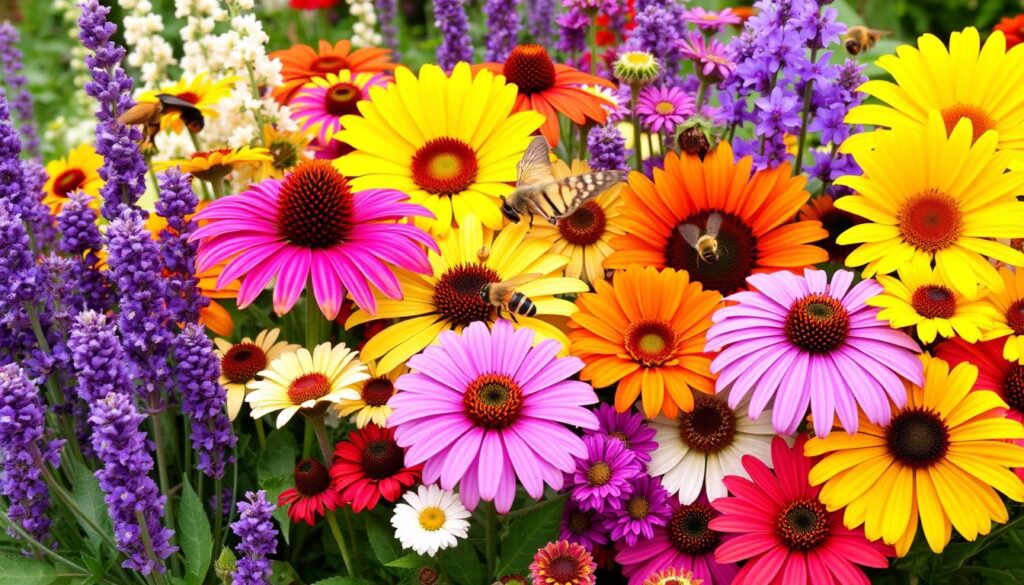
When planning your garden, add a mix of annual and perennial flowers that attract pollinators. This will make your garden healthier and more productive. You’ll get a lot of fresh, nutritious food.
| Annual Flowers for Pollinators | Perennial Flowers for Pollinators |
|---|---|
|
|
“By attracting a diverse array of pollinators to your vegetable garden, you’ll not only enjoy a more productive harvest but also contribute to the overall health of your local ecosystem.”
Plants for Pest Control
Gardeners can use companion plants for a natural pest control in small vegetable plots. These plants help by keeping pests away and bringing in beneficial insects. These insects eat common garden pests.
Repelling Pests with Fragrant Herbs
Some herbs like sage, rosemary, and garlic keep pests away. Their strong smells can chase off insects and animals like deer and rabbits. This protects your vegetables.
Distracting Pests with Trap Crops
Trap crops draw pests away from your main plants. Nasturtiums and radishes are great for this. They attract pests like aphids and cucumber beetles, keeping them away from your vegetables.
Attracting Beneficial Insects
Plants like dill and sweet alyssum attract helpful insects. Ladybugs and wasps come to these flowers and eat pests. This keeps the garden balanced and cuts down on the need for harmful chemicals.
Using different companion plants makes a garden a natural pest control system. These plants keep pests away, distract them, and bring in their enemies. This creates a healthy garden environment.
Companion Planting Examples
Companion planting is key for small vegetable gardens. It helps keep pests away and makes plants grow better. A top pair is basil and tomatoes. Basil’s strong smell keeps pests like thrips and moths away from tomatoes.
Marigolds are another great choice for companion planting. They keep pests like nematodes away from many vegetables. Adding these bright flowers to your garden helps control pests naturally. This makes your garden healthy and easy to care for.
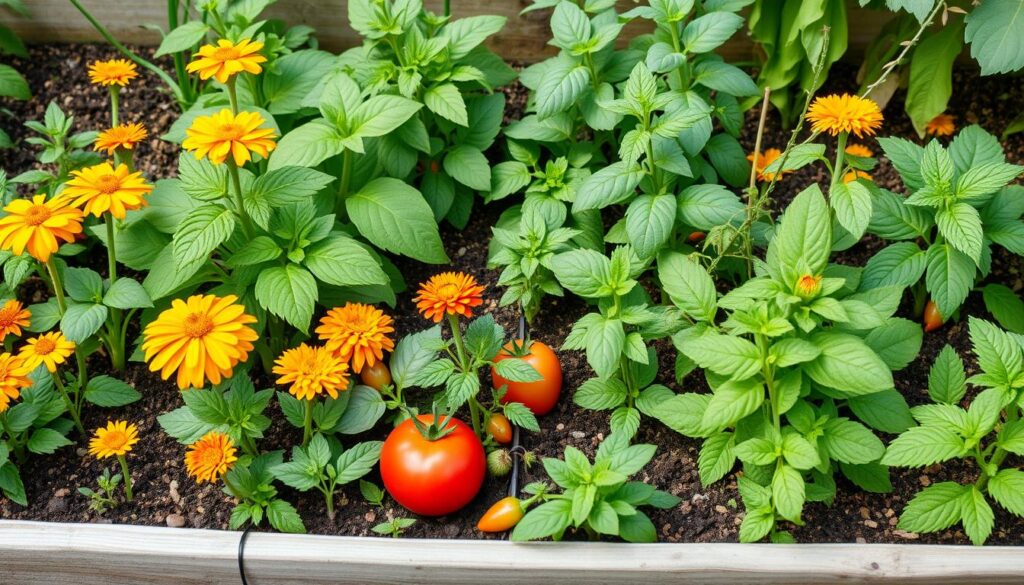
“Companion planting is a time-tested technique that allows gardeners to create a diverse, thriving ecosystem right in their own backyards.”
By knowing how different plants work together, you can make a garden that looks good and fights pests. Planting basil with tomatoes or marigolds with other veggies is a smart move. Companion planting is a big win for your garden’s health and productivity.
Companion planting for small gardens
When using companion planting in a small garden, planning is crucial. Pick compact vegetables and grow them with other plants in pots. This way, you get a garden that’s full of life and doesn’t take up too much space.
Compact Companions for Cozy Corners
Find space-saving gardening techniques and pick compact vegetable varieties that fit well in small spaces. Pair these with other plants that grow well in pots or together. This method helps with pest control, better soil, and more pollinators without using up too much space.
Potted Pairings for Patio Perfection
Using pots is a great way to grow plants in small gardens. Put herbs, flowers, and legumes in pots around your vegetables. This saves space and lets you control how plants work together.
| Compact Vegetable Varieties | Companion Plants for Pots |
|---|---|
| Bush Beans | Marigolds, Radishes |
| Cherry Tomatoes | Basil, Chives |
| Dwarf Peppers | Nasturtiums, Parsley |
Plan and arrange your plants carefully to make a small garden that’s both beautiful and productive. It uses the power of plants working together to improve your garden.
The Science Behind Companion Planting
As a savvy gardener, you’ll be happy to learn that companion planting is now supported by science. This approach is proven to be effective in the garden. It offers a natural way to manage pests without harsh chemicals.
Studies reveal that some plants work together to reduce pests. For example, herbs with strong smells can keep pests away. They release compounds that insects find unappealing.
Other plants act as “trap crops.” They draw pests away from the main crops, acting as a decoy. This helps protect the plants you want to grow.
Flowering plants also play a role by attracting beneficial insects. Ladybugs and parasitic wasps are drawn to these flowers. They then help control pests in the garden. This shows that companion planting is a smart way to keep pests at bay naturally.
FAQ
What is companion planting?
Companion planting means growing different plants together to help each other out. This can make plants grow better, keep pests away, and increase the amount of food you get from your garden.
What are the benefits of companion planting?
Growing plants together has many perks. It keeps pests away, draws in good bugs, controls shade, offers natural support, boosts plant health, enriches the soil, and fights weeds.
How can companion planting be used in small vegetable gardens?
In small gardens, you can use companion plants in pots or mix them with vegetables. This saves space and makes the most of your garden area. It helps you enjoy the benefits of companion planting without losing valuable space.
What plants can be used to attract pollinators?
Plants like borage, zinnia, and cosmos attract bees and butterflies. Perennials like bee balm and lavender also draw in pollinators to your garden.
What companion plants can be used for pest control?
Herbs like sage, rosemary, and garlic keep insects away with their strong smells. Trap crops like nasturtiums and radishes pull pests away from your main crops. Flowers like dill and sweet alyssum bring in beneficial insects that eat garden pests.
Can companion planting be backed by scientific research?
Yes, science now supports companion planting. Studies show that some plant pairs can reduce pests by repelling them, distracting them, or attracting beneficial insects.
Source Links
- Companion Planting Chart and Guide for Vegetable Gardens – https://www.almanac.com/companion-planting-guide-vegetables
- Companion Planting for the Veggie Garden – https://www.gooseberrygardens.ca/post/companion-planting-for-the-veggie-garden
- Companion Gardening Guide: Companion Planting for Garden Pest Control – https://zerowastehomestead.com/companion-gardening-guide-how-to-use-companion-planting-for-garden-pest-control/
Container Gardening Essentials: Choosing the Right Pots, Soil, and Plants
Are you ready to turn your living space into a lush oasis? Container gardening lets you grow many plants, even in small spaces like your home or apartment. But where do you start? The key to indoor gardening success is knowing the basics: the right soil, perfect containers, and plants that do well in your space.
Key Takeaways
- Soil is the foundation of healthy plants, and different types serve various purposes in indoor gardening.
- Selecting the right containers is crucial, as they impact drainage, root growth, and overall plant health.
- Matching your plants’ needs with the appropriate soil and container is the key to creating a thriving indoor oasis.
- Understanding sunlight requirements, watering needs, and pest control are essential for maintaining your container garden.
- Exploring resources and seeking inspiration can help you unlock the full potential of your indoor gardening journey.
Introduction: The Joy of Indoor Gardening
Gardening isn’t just for the outdoors anymore. Indoor gardening has become a popular way to bring nature inside. It lets you grow a beautiful garden right in your home. You can enjoy the beauty of nature or grow your own food all year.
Key Takeaways
- Indoor gardening lets you enjoy plants and fresh produce anytime, no matter the season or weather.
- Picking the right soil and containers is key for a successful indoor garden.
- Each plant has its own needs, so tailor your care to help them grow well.
- Good drainage is vital to stop root rot and keep your plants healthy.
- Keeping your soil fresh and maintained is important for a lush garden.
- Trying new things and adjusting your methods is crucial to find what works best for you.
Indoor gardening lets you turn your home into a green oasis full of nature’s beauty and goodness. Discover the secrets of indoor gardening and start a journey of growth and happiness.
“Gardening is my therapy. It’s a way for me to reconnect with nature and find a sense of peace and balance in my life.”
Understanding Soil Types and Composition
Soil is key to feeding and supporting your indoor plants. Knowing the different soil types and their compositions is vital for a successful indoor garden. Let’s look at the main soil options for indoor gardening: potting mix, organic soil, and hydroponic mediums.
Soil Types for Indoor Gardening
Potting Mix: Made for container gardens, potting mix is light and drains well. It stops soil from getting too dense. This mix helps plants get the air and water they need.
Organic Soil: Full of natural compost and organic stuff, organic soil feeds your plants well. It helps plants grow without synthetic chemicals, which is good for the planet.
Hydroponic Mediums: For hydroponic gardening, mediums like coconut coir, perlite, and vermiculite are used. They give plants the support and air they need in water-based systems.
| Soil Type | Key Characteristics | Best Suited For |
|---|---|---|
| Potting Mix | Lightweight, well-draining, prevents soil compaction | Container gardening, promoting air and water flow |
| Organic Soil | Nutrient-rich, made from natural compost | Supporting plant growth without synthetic chemicals |
| Hydroponic Mediums | Soil-less options like coconut coir, perlite, vermiculite | Hydroponic gardening, providing aeration and support |
Understanding these soil types and their uses helps you pick the best one for your plants. This way, you can create a great indoor garden.
Matching Soil to Your Plants’ Needs
Choosing the right soil is key for indoor gardening. Indoor plants rely on the potting mix you pick. So, it’s vital to match the soil to what your plants need for them to do well.
Factors to Consider
When picking the right soil for indoor plants, think about these things:
- Plant Type: Different plants need different nutrients and like certain pH levels. Succulents and cacti do well in dry, slightly alkaline soil. On the other hand, African violets and azaleas like acidic soil.
- Moisture Retention: Some plants, like succulents and herbs, like dry soil. Others, such as tropical plants and ferns, need moist soil.
- pH Levels: Most indoor plants do best in slightly acidic to neutral pH levels. A mix of different soils can meet your plants’ specific needs.
By thinking about these factors, you can make a soil mix that’s perfect for your indoor plants. This leads to healthier, more beautiful plants.
Container Gardening Essentials: Choosing the Right Pots
Container Basics for Indoor Gardeners
Choosing the right pots is key to a healthy and thriving indoor garden. It’s not just about looks; it affects your plants’ success. Let’s look at what makes the perfect gardening containers.
The container materials matter a lot. Plastic pots are durable and easy on the wallet. Clay pots help with drainage and air flow. Fabric pots prevent roots from getting tangled and help roots grow strong.
Size of the container size is also crucial. Your pots should be big enough for your plants to grow fully. Too small can stunt growth, and too big can cause root rot. It’s all about finding the right balance for your plants.
| Container Material | Pros | Cons |
|---|---|---|
| Plastic | Durable, affordable | May not provide optimal drainage or air circulation |
| Clay | Excellent drainage, promotes air flow | Can be more fragile, and may be heavier |
| Fabric | Prevents root-binding, promotes healthy root systems | May require more frequent watering |
Choosing the right gardening containers and size is key to a successful indoor garden. Think about what your plants need in terms of material and size. This will help you create a beautiful and thriving indoor space.
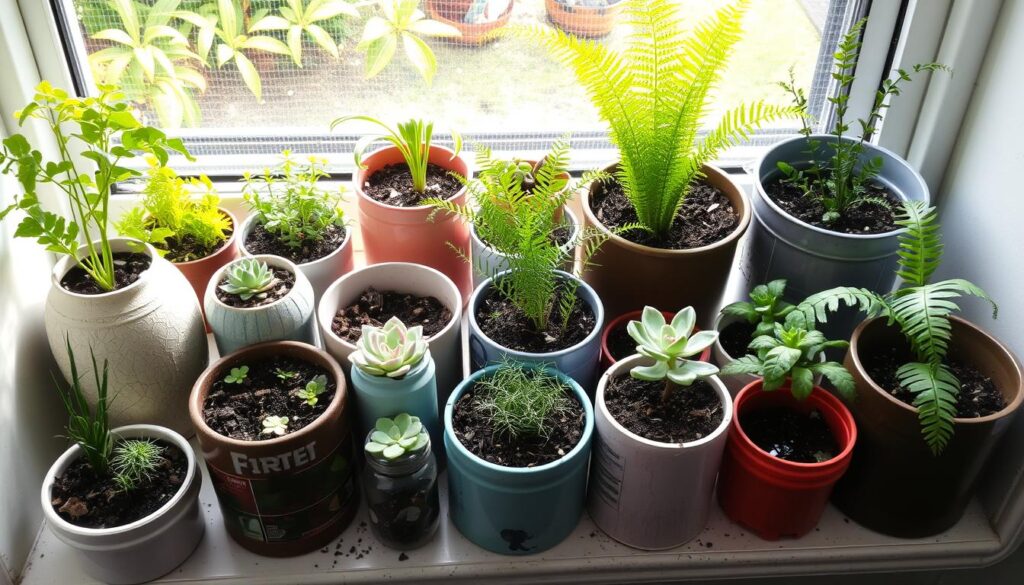
Drainage: The Key to Healthy Indoor Plants
Keeping your indoor plants healthy and long-lasting starts with good container drainage. It’s key to stop water from building up at the bottom of containers. This can cause root rot and other diseases. By managing water well, you help your plants grow strong and healthy.
To make your indoor plants thrive, follow a few easy steps. Use pots with holes at the bottom to let water out. This keeps the soil just right. Also, add pebbles or broken terra cotta at the bottom to help with drainage.
- Use containers with ample drainage holes
- Add a layer of pebbles or broken terra cotta at the bottom of the pot
- Choose a well-draining potting mix suitable for your indoor plants
By doing these things, you make a great place for your plants to live. Good drainage stops water problems and helps your garden do well.
“Proper drainage is essential for the long-term success of your indoor plants. It’s the foundation for a healthy, vibrant indoor garden.”
Maintaining Soil Health and Container Condition
For your indoor garden to thrive, it’s important to keep the soil and containers in good shape. Regular checks on soil health and refreshing the soil help your plants get the nutrients they need.
Nurturing Soil Health
Start by checking the soil moisture often. Don’t let it get too dry, as this can harm your plants. Also, give the right fertilization based on what your plants need. It’s key to keep an eye on the pH levels to make sure your plants get the nutrients they need.
Repotting and Soil Refreshment
Soil in containers can get compacted and lack nutrients over time. You’ll need to repot your plants and refresh the soil now and then. This helps to aerate the soil and add back the minerals your plants need to grow well.
“Regular soil maintenance is the key to a thriving indoor garden. Take the time to care for your container’s growing medium, and your plants will reward you with abundant, vibrant growth.”
By focusing on soil health, maintenance, and repotting, your container garden will stay lush and vibrant. Healthy soil is the key to a successful indoor garden.
Troubleshooting Common Issues
Starting an indoor garden can be very rewarding, but it’s not always easy. You might face problems like root rot, stunted growth, and leaf discoloration. These issues can be frustrating for even the most experienced gardeners. But, with the right steps, you can fix these problems and keep your garden healthy.
Poor drainage is often the main cause of indoor gardening problems. If your containers don’t drain well, you might get root rot. This happens when roots stay too wet and start to rot. Make sure your containers have good drainage holes and don’t let the soil get too wet.
Stunted growth can happen for many reasons, like not enough light, not enough nutrients, or being in a small pot. Check how your plants are doing and change things if needed. This might mean giving them more light or moving them into a bigger pot.
- Look at your plants often for signs of leaf discoloration. This could mean pests, diseases, or not enough nutrients.
- Change how you water your plants to avoid giving them too much or too little water.
- Think about changing the soil in your containers to give your plants the best place to grow.
By tackling these common problems, you can keep your indoor plants healthy and your garden looking great. This way, you’ll have a beautiful indoor space to enjoy.
| Challenge | Potential Causes | Solutions |
|---|---|---|
| Root Rot | Overwatering, poor drainage | Improve container drainage, adjust watering practices |
| Stunted Growth | Insufficient light, nutrient deficiencies, root-bound plants | Provide more light, fertilize, repot into larger container |
| Leaf Discoloration | Pests, disease, nutrient imbalances | Inspect plants, treat pests or disease, adjust soil nutrition |
Further Resources and Inspiration
Starting your indoor gardening journey can be exciting. There are many resources to help you grow a beautiful indoor garden. From guides to books, you can find lots of information to make your gardening easier.
The Beginner’s Guide to Indoor Gardening is great for new gardeners. It covers the basics of indoor gardening. You’ll learn about choosing the right plants and keeping them happy at home.
For those wanting to learn more about container gardening, The Secrets to Successful Container Gardening is a good choice. It talks about soil, pots, and how to pair plants for a beautiful garden.
Gardening guides with step-by-step instructions are also helpful. How to Create the Perfect Plant Environment at Home gives tips on lighting, humidity, and temperature for your plants.
Soil testing kits are also important for indoor gardens. They help you understand what your plants need. By testing the soil, you can make sure your plants get the right water and food.
No matter your gardening skill level, using all the resources out there can inspire you. It can help you turn your home into a peaceful garden oasis.
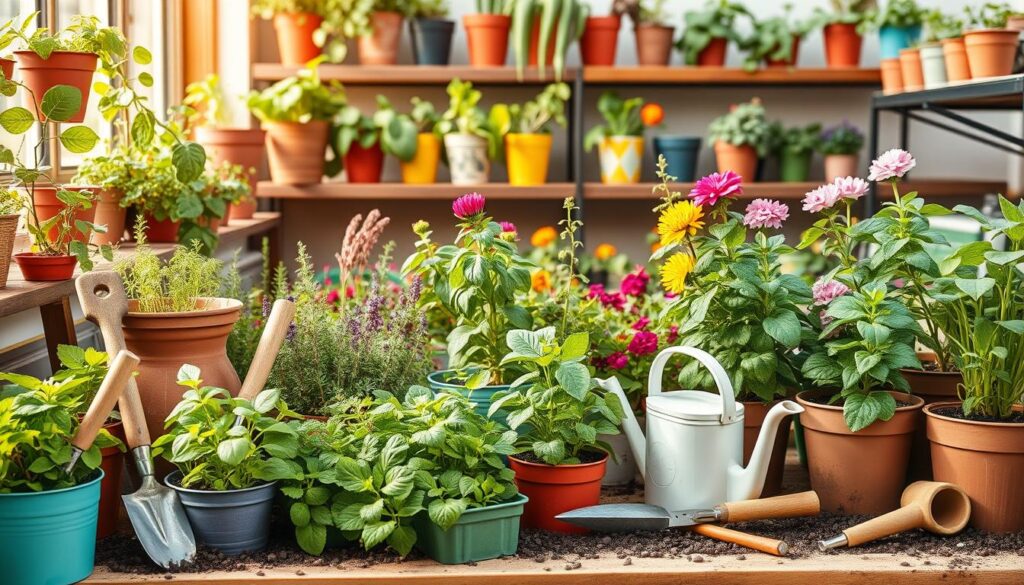
“With the right tools and knowledge, anyone can cultivate a thriving indoor garden and enjoy the countless benefits of nature within their own home.”
Conclusion
We’ve looked into the key parts of indoor gardening, like choosing the right soil and containers for healthy plants. It’s important to know about different soil types and how to pick containers that fit your plants. Making sure the soil drains well and keeping it healthy is also key for a successful garden.
While there are guidelines and best practices, the real skill in indoor gardening is trying new things. Every plant is different, so what works for one might not work for another. I suggest trying out various soil mixes and containers to find the best match for your plants.
Patience, care, and learning are the keys to a great indoor garden. As you learn and gain experience, your garden will grow in size, beauty, and life. Enjoy your gardening journey!
FAQ
What are the essential soil types for indoor gardening?
For indoor gardening, you’ll need potting mix, organic soil, and hydroponic mediums. Each type has its own purpose and meets different plant needs.
How do I choose the right soil for my indoor plants?
Think about the type of plant, how much moisture it likes, and the pH level it needs. This helps pick the best soil for your plants.
What should I look for when choosing containers for my indoor garden?
Look at the material, size, and how well they drain. These factors help keep your plants healthy and happy.
Why is proper drainage important in indoor gardening?
Good drainage stops water from building up and causing root rot. It keeps the soil moist but not too wet.
How do I maintain the soil and containers in my indoor garden?
Check the soil’s moisture often, feed your plants right, and repot or refresh the soil when needed. This keeps your plants healthy.
What are some common issues I might face with my indoor garden, and how can I resolve them?
Issues like root rot, slow growth, or color changes can be fixed. Adjust how you water, improve drainage, or refresh the soil.
Where can I find more resources to enhance my indoor gardening journey?
There are many books and online guides for beginners and experts. They can help you learn more and get inspired for your garden.
Source Links
- Indoor Gardening Essentials: Choosing the Right Soil and Containers – https://tendsupplies.com/blog/indoor-gardening-essentials-choosing-the-right-soil-and-containers/
- What is the Best Soil for Container Gardening – EarthBox – https://earthbox.com/blog/what-is-the-best-soil-for-container-gardening
- The Best Guide To Outdoor Container Gardening For Beginners – https://thewellco.co/container-gardening-for-beginners/
Vertical Gardening Techniques: Maximizing Your Small Space with Climbers and Vines
Feeling cramped in your small garden? Vertical gardening could be the answer. It lets you use your yard, patio, or balcony’s vertical space to grow a lush garden. This way, you can make the most of every inch available. But what is vertical gardening, and how can you use it best?
Key Takeaways
- Vertical gardening lets you grow more in a small space by using walls, trellises, and other vertical structures.
- Climbing and vining plants are great for vertical gardening. They give you a lot of produce without using up ground space.
- Techniques for vertical gardening include using elevated containers, hanging baskets, living walls, and more. These methods create a beautiful and productive garden.
- Vertical gardening is perfect for small areas like balconies, patios, and city gardens. It’s great when traditional gardening isn’t possible.
- Choosing and taking care of your vertical garden properly helps you get a big harvest and a beautiful, space-saving garden.
Introduction to Vertical Gardening
Vertical gardening is a new way to make the most of your space. It uses trellises, arbors, and shelves to grow plants in small areas. This method makes your outdoor space look better and has many practical benefits.
Benefits of Vertical Gardening
Choosing vertical gardening brings many advantages, including:
- Increased growing capacity in limited spaces
- Reduced risk of pests and diseases due to improved air circulation
- Easier maintenance and accessibility for tasks like watering and harvesting
- Enhanced visual interest and curb appeal for your property
Types of Vertical Gardening Techniques
There are several vertical gardening methods to try, each with its own benefits:
- Elevated Containers: Raising your planters off the ground can maximize your growing space and improve drainage.
- Hanging Baskets: Suspend baskets from hooks, trellises, or shelves to create a captivating vertical display.
- Green Walls: Build a living, vertical garden using a specialized system of pockets or panels to hold soil and plants.
- Shelf Systems: Arrange tiered shelves to accommodate a variety of plants, from trailing vines to upright herbs and vegetables.
By learning about the benefits of vertical gardening and the different techniques, you can turn your small space into a lush, efficient garden. Start with vertical gardening to make the most of your outdoor area.
Vertical Gardening Techniques
Vertical gardening lets you use every inch of space, even in small areas like balconies or narrow yards. You can grow many plants, like vining veggies, fruits, and climbing flowers and herbs, in a smart way.
Using elevated containers is a great method. Put your plants on tiered shelves or in hanging baskets for a colorful, layered garden. Trellises and arbors are also good, giving plants something to climb on.
If you’re short on outdoor space, try green walls or vertical shelf systems. Green walls turn plain walls into green havens. Vertical shelves stack your plants up, using every inch well.
| Vertical Gardening Technique | Description | Best Suited Plants |
|---|---|---|
| Elevated Containers | Tiered shelves or hanging baskets that create a multi-layered garden | Vining vegetables, trailing herbs, and cascading flowers |
| Trellises and Arbors | Sturdy structures that support the growth of climbing plants | Cucumbers, tomatoes, peas, and flowering vines |
| Green Walls | Living walls that transform bare surfaces into lush, vertical gardens | Ivy, philodendrons, and other trailing foliage plants |
| Vertical Shelf Systems | Stacked shelves that allow you to grow plants vertically | Herbs, small-space vegetables, and compact flowering plants |
With these vertical gardening techniques, you can make a beautiful, efficient garden. It’s perfect for urban or small-space gardening.
Plants Suitable for Vertical Gardening
Vertical gardening is great for making the most of small spaces. Certain plants are perfect for this, like vining vegetables, climbing flowers, and herbs. They turn your small area into a lush, full garden.
Vining Vegetables
Cucumbers, pole beans, and pumpkins are great for vertical gardens. They love to climb and grow well when given the chance. With trellises or cages, they can grow high and look beautiful in your garden.
Vining Fruits and Berries
Grapes, blackberries, and raspberries are great for vertical gardens too. Their vines can climb up, letting you grow lots of tasty treats in a small space. They also make your garden look pretty with their leaves and flowers.
Climbing Flowers and Herbs
Vertical gardens are perfect for climbing flowers and herbs. Plants like nasturtiums, morning glories, and hops do well climbing. They make your vertical garden look beautiful and smell great.
“Vertical gardening allows you to grow a diverse array of plants in a small footprint, transforming even the most limited spaces into a verdant oasis.”
Choosing the right plants for your vertical garden makes it better in many ways. You get more harvest, a beautiful look, and enjoy the benefits of this new gardening method.
Maintaining Your Vertical Garden
Keeping your vertical garden healthy and full of life takes a bit of extra effort. You need to focus on watering and fertilizing your plants. This ensures they grow well and look great.
It’s important to water your vertical garden often. The plants dry out faster in elevated containers than those on the ground. Using a watering wand or drip irrigation is a good way to keep your plants moist.
Feeding your plants the right nutrients is also key. Different plants need different foods. Make sure to learn what your vertical garden maintenance plants need. Using a balanced, organic fertilizer regularly can help your plants grow strong.
As plants get taller, they might need extra support. You can use stakes, trellises, or other watering vertical gardens tools to keep them upright. This helps your climbers grow upwards.
By taking care of your vertical garden’s special needs, you can keep it looking great. With a little extra effort, your fertilizing vertical gardens will look amazing and produce a lot.

Maximizing Small Spaces with Climbers and Vines
Using climbers and vines in vertical gardens is a great way to make the most of small garden areas. These plants grow upwards, letting you use more space without taking up ground. Plants like cucumbers, pole beans, grapes, and nasturtiums work well for this, making your garden look lush and efficient.
These plants grow up, not out, which helps avoid pests, diseases, and soil problems. By using climbers and vines, you can turn a small space into a beautiful, productive garden.
“Vertical gardening allows you to grow more in less space, creating a lush and visually appealing display that’s both practical and beautiful.”
If you have a tiny balcony, a small courtyard, or a modest backyard, vertical gardening is perfect. With the right plants and supports, you can make your space look great and be productive.
Vertical gardening techniques
Urban gardening or using a small outdoor space? Vertical gardening techniques are a great choice. They let you use climbers, vines, and support structures to make even a tiny balcony or yard into a garden. This way, you can grow more plants in less space.
One big plus of vertical gardening techniques is how they save space. You can use elevated containers, hanging baskets, trellises, green walls, and shelf systems. This lets you grow a mix of plants like vining veggies, fruits, and climbing flowers and herbs in a small area.
To start with vertical gardening, try these methods:
- Trellises and Arbors: These structures help vining plants like pole beans, peas, cucumbers, and melons grow up. This saves space and makes the most of your area.
- Green Walls: Also called living walls, these systems let you grow herbs, succulents, and small veggies in a small space.
- Hanging Baskets and Shelves: Hanging baskets or shelves on walls or fences are great for trailing plants, cascading flowers, and small edibles.
Using these vertical gardening methods can turn your small garden into a lush, space-saving oasis. With creativity and the right support, you can make the most of your space. You’ll enjoy a full harvest and improve your outdoor area’s look.
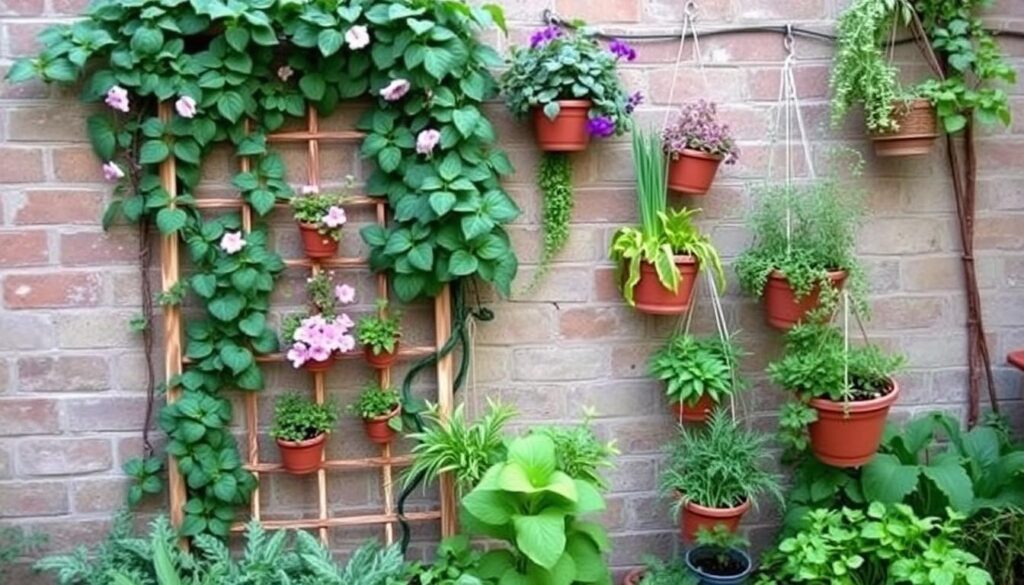
| Vertical Gardening Technique | Benefits | Suitable Plants |
|---|---|---|
| Trellises and Arbors | Efficient use of space, improved air circulation, easier harvesting | Pole beans, peas, cucumbers, melons |
| Green Walls | Maximized growing area, aesthetic appeal, potential for edibles | Herbs, succulents, small vegetables |
| Hanging Baskets and Shelves | Space-saving, versatile for trailing and cascading plants | Trailing flowers, small-scale edibles |
“Vertical gardening techniques allow you to grow a wide variety of plants in a limited space, transforming even the smallest outdoor areas into productive and visually stunning gardens.”
Vertical Garden Designs and Ideas
Vertical gardening opens up many design options for small spaces. You can use simple trellises or create stunning living walls. Let’s look at some inspiring ways to add vertical elements to your garden.
Trellis Gardens
Trellis gardens are a great way to start with vertical gardening. They use mesh, lattice, or other supports for plants to climb. This is perfect for growing vertical garden design veggies like cucumbers, pole beans, or tomatoes. You can also grow beautiful vines.
Living Walls
Living walls offer a deep vertical gardening experience. They attach pots or planters to a wall, letting many plants grow in a small space. These walls turn plain walls into green spaces, adding beauty and life to any area.
Vertical Container Gardens
Vertical container gardens are smart for small spaces. You can use stacked pots or custom planters to grow different plants. This method lets you create a unique vertical garden design that fits your style and needs.
By trying out these vertical garden design ideas, you can turn small areas into lush gardens. These gardens mix beauty with function, making any space better.
Environmental Benefits of Vertical Gardening
Vertical gardening is a new way to use space well. It has many benefits for the environment. Living walls help cool buildings and increase biodiversity in cities.
Living walls can make buildings up to 50 degrees Fahrenheit cooler. This means less need for air conditioning and lower energy bills. They also keep indoor temperatures steady, saving more energy.
Vertical gardens can block noise pollution too. They’re perfect for cities where peace is hard to find. These gardens also help local wildlife by offering homes, food, and shelter. This boosts the local ecosystem.
With vertical gardening, you can grow more in a small area. It’s good for your space and the planet. Vertical gardens and energy efficiency work together well.
“Vertical gardening is a smart and sustainable solution that can transform urban landscapes, providing a wealth of environmental benefits for communities and the planet.”
Conclusion
Vertical gardening is a great way to make the most of small outdoor spaces like balconies, decks, or small yards. It uses climbers and vines to increase your growing area and give you more harvest. This method boosts your garden’s productivity and has many other benefits.
It makes gardening easier, cuts down on pests and diseases, and helps the environment by using less energy and supporting more life. By trying out different vertical gardening methods and picking the right plants, you can turn a small space into a lush, sustainable garden. It adds beauty, productivity, and a bit of city charm to your outdoor area.
Whether you’re new to gardening or have been doing it for years, vertical gardening offers a way to create a beautiful, efficient garden. It meets your specific needs and tastes. So, start using vertical gardening to explore the possibilities in your small space. Use climbers and vines to make a garden that feeds you and helps the planet.
FAQ
What are the benefits of vertical gardening?
Vertical gardening lets you grow more plants in a small space. It makes maintenance easier and helps reduce pests and diseases. This method is perfect for balconies, decks, or small yards.
What are the different types of vertical gardening techniques?
There are many ways to do vertical gardening. You can use elevated containers, hanging baskets, or trellises. Green walls, arbors, and shelf systems are also options. Each method lets you grow a variety of plants in a small area.
What plants are best suited for vertical gardening?
Plants like cucumbers, pole beans, and pumpkins grow well vertically. So do fruits and berries like grapes and raspberries. Climbing flowers and herbs, such as nasturtiums and hops, also do great in vertical gardens.
How do I maintain a thriving vertical garden?
Vertical gardens dry out fast, so they need regular watering. Use a watering wand or drip system. Also, make sure to fertilize and provide support with stakes or trellises for your plants.
What are the environmental benefits of vertical gardening?
Vertical gardens can cool buildings and reduce noise. They also increase biodiversity by offering shelter and food for birds and insects. Using vertical gardening helps create a healthier, more sustainable environment.
What are some different vertical garden designs and ideas?
You can choose from trellis systems, living walls, or stacked container gardens. These options let you match your space and style preferences.
Source Links
- Vertical Gardening for Small Spaces – https://mostardi.com/vertical-gardening-for-small-spaces/
- 12 Vertical Gardening Ideas to Turn Your Small Space Into an Outdoor Paradise – https://www.lawnstarter.com/blog/landscaping/vertical-gardening-ideas/
- Creative Ideas for Vertical Gardening and Planting – https://www.azurefarmlife.com/farm-blog/vertical-gardening-plants-benefits-and-tips-for-a-gorgeous-vertical-garden
How to Build a Raised Bed Garden in a Small Backyard: Step-by-Step Guide
Do you dream of turning your small backyard into a garden full of fresh produce? Raised bed gardening is the answer for making the most of your space and growing a lot of food. We’ll guide you through building a raised bed garden that fits your small backyard, showing you how to succeed in compact gardening.
Picture the joy of picking fresh tomatoes, carrots, or herbs from your own yard, all while saving space and effort. Raised bed gardening is great for city dwellers, those living in small spaces, and anyone with little outdoor area. By lifting your beds, you get better soil, fewer pests and weeds, and easier gardening.
Key Takeaways
- Raised bed gardening is perfect for small backyards, compact living, and city gardens
- Elevated beds mean better soil, fewer pests and weeds, and easier gardening
- Follow our steps to build your own raised bed garden, from planning to planting and care
- Find ways to customize your garden for a better experience
- Turn your small outdoor space into a productive and beautiful garden
Benefits of Raised Bed Gardening in Small Backyards
Turning your small backyard into a garden oasis is easier with raised beds. These elevated areas offer many benefits. They make gardening better and help you get great results, even in small spaces.
Better Soil Quality Control
Raised beds let you control your soil quality. Fill them with a nutrient-rich mix or compost for the best growing conditions. This is great if your backyard soil is poor or contaminated, a common issue in cities.
Pest and Weed Prevention
Raised beds keep pests and weeds out. Use hardware cloth or landscape fabric at the bottom to stop gophers and moles. This also stops weed seeds from growing, saving you time on weed control.
Ergonomic Gardening
Raised beds are at a comfortable height, making gardening easier. They reduce back and joint strain, letting you work longer without pain. They’re also great for people with mobility issues, making gardening more enjoyable and beneficial.
Embracing raised bed gardening turns your small backyard into a lush, easy-to-maintain oasis. It’s accessible to everyone. Enjoy the benefits of better soil quality, effective pest and weed control, and ergonomic gardening.
Planning Your Raised Bed Garden Layout
When planning a raised bed garden in a small backyard, picking the right spot is key. Look for a place that gets lots of sun all day and season. Stay away from areas shaded by buildings, trees, or other structures, as most plants need at least 6 hours of sunlight daily. Think about how the sun moves over the year and its impact on your garden location.
Choosing the Right Location
The amount of sun exposure and shade in your backyard affects where you should put your raised beds. Look for microclimates in your yard, where the weather might be different. These spots can affect how well your plants grow and stay healthy.
Determining the Size and Number of Beds
The size and number of raised beds should fit your small backyard’s space. It’s best to keep beds 8-10 feet long and 4 feet wide. This size makes it easy to reach into the bed and prevents soil from getting compacted. When designing your layout, leave 28-36 inches between beds for paths. Try out different bed spacing and raised bed sizes to use your space well and boost your garden’s yield.
| Raised Bed Dimension | Recommended Size |
|---|---|
| Length | 8-10 feet |
| Width | 4 feet |
| Spacing Between Beds | 28-36 inches |
“Choosing the right location and considering the size and number of raised beds is crucial for maximizing the productivity of your small backyard garden.”
Raised bed garden in small backyard
If you have a small backyard or live in an urban area, raised bed gardening can change the game. By building elevated garden beds, you can turn even the smallest outdoor space into a place that’s both productive and beautiful. Raised beds are great for urban gardening and container gardening. They let you make the most of your small backyard garden and use intensive planting methods.
One big plus of raised beds is the control you have over the soil. You can pick the perfect mix, avoiding weeds, pests, and other problems that come with regular gardening. This is a big win for urban gardeners facing tough soil or limited space.
| Key Benefits of Raised Bed Gardening in Small Backyards |
|---|
|
Adding raised beds to your small backyard garden lets you create a lush oasis. It’s not just about growing food; it also makes your outdoor space look better. With some planning and creativity, even the smallest backyard can become a beautiful container gardening spot.
“Raised bed gardening is a game-changer for small-space gardeners, allowing them to create a productive and visually stunning oasis in even the most limited outdoor areas.”
Materials and Tools Needed
Starting a raised bed gardening project in your small backyard needs careful planning. You’ll need the right materials and tools to make a garden that looks great and grows well.
For the raised bed frames, use lumber like cedar or redwood. These woods are strong and won’t rot easily. For the inside of the bed, think about hardware cloth or landscape fabric. They keep weeds and pests out.
When it comes to gardening tools, you’ll need a saw for cutting wood. Choose between a miter saw or a circular saw. A drill and screwdriver are key for putting the bed frames together. And, a measuring tape is crucial for getting the right size. You’ll also need basic gardening implements like shovels, rakes, and trowels for upkeep.
Remember, safety first. Always wear gloves, goggles, and a respirator during your DIY project.
With the right raised bed materials and gardening tools, you’re set to turn your small backyard into a lush raised bed garden.
“The secret to a successful raised bed garden lies in the careful selection of materials and tools.”
Step-by-Step Instructions for Building Raised Beds
Building a raised bed garden in your small backyard is a rewarding DIY project. It can change your outdoor space for the better. First, focus on the foundation – preparing the ground. Leveling the ground is crucial for stable raised beds and good drainage.
Leveling the Ground
Begin by checking the area for any high or low spots. Use a shovel to fix these areas by digging or adding paving sand or gravel. This makes a solid, even base for your raised beds, ensuring good drainage and stability.
Assembling the Bed Frame
After leveling the ground, start building the raised bed frame. Measure and cut your lumber to the right size. Choose strong materials like untreated cedar, redwood, or pressure-treated wood. Use 4×4 posts for corners and deck screws to hold the boards together. Make sure the frame is square and stable. Adding extra posts along the sides helps with support.
Lining the Bed
To stop pests and weeds, line the bed with hardware cloth or landscape fabric. This keeps your garden clean and healthy. For better drainage, put gravel or crushed stone at the bottom of the bed before adding soil.
Follow these steps for raised bed construction, ground preparation, leveling, and drainage. You’ll be on your way to a thriving raised bed garden in your small backyard. The strong raised bed frame, corner posts, and fasteners with a weed barrier and gopher protection will help you have a successful garden.
Filling Your Raised Beds with Soil
Filling your raised beds with the right soil is key to a great garden. Use a mix of topsoil, compost, and other organic stuff. Don’t use soil from the ground because it might have weeds, pests, or bad drainage.
Before you start, measure the soil you need for each bed. This makes sure you have enough for your plants to grow well. After measuring, mix in the soil additives well before you plant.
- Aim for a soil depth of 8-12 inches for most vegetables and herbs.
- Mix in organic matter such as compost to improve soil structure and nutrient-rich soil.
- Consider adding soil amendments like perlite or vermiculite to enhance raised bed soil drainage and aeration.
| Soil Amendment | Benefit |
|---|---|
| Compost | Adds organic matter and improves soil structure |
| Perlite | Enhances drainage and aeration |
| Vermiculite | Improves water-holding capacity and nutrient-rich soil |
By choosing the right soil amendments and organic matter, you make a great place for your plants to grow. This will help them stay healthy all season.
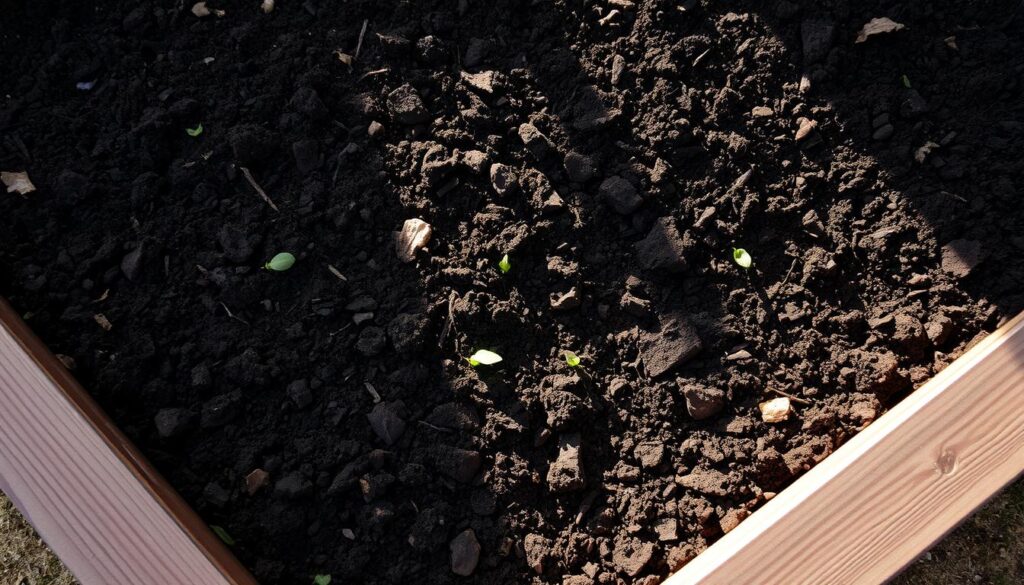
“The key to a thriving raised bed garden is in the soil. Invest in quality, nutrient-rich materials to lay the foundation for success.”
Planting in Your Raised Beds
When planning your raised bed garden in a small backyard, think about what plants will work best. Pick a mix of vegetables, herbs, and flowers that love the sun and growing conditions in your garden. Consider the size, growth, and how plants work together to plan your garden well.
Choosing the Right Plants
Pick a variety of plants for your raised beds, including quick-growing ones, vines, and tall plants for vertical gardening. This way, you can grow many different foods in a small area. Use trellising and other supports to make the most of your space.
Planting and Spacing
Getting the spacing right is crucial for a successful garden. Follow the advice on seed packets and plant tags to give each plant enough room. Use intensive planting methods to grow more in your small garden.
“The joy of gardening lies in the process, not just the final harvest. Take your time, experiment, and enjoy the journey.”
Raised bed gardening in a small space lets you try out companion planting and make a beautiful, productive garden. By choosing the right plants and arranging them well, you can make the most of your space and enjoy a great harvest.
Watering and Maintenance
Looking after a raised bed garden in your small backyard takes some routine, but it’s worth it. Let’s look at watering and garden care to keep your plants healthy.
Efficient Raised Bed Watering
Watering your raised bed plants right is key. Think about getting a drip irrigation system or soaker hoses. These methods send water straight to the roots, cutting down on waste and runoff.
Keeping Weeds at Bay
It’s important to keep weeds out of your raised bed garden. Check your beds often and pull out any weeds that pop up. Adding mulch around your plants can also stop weeds and keep the soil moist.
Nourishing Your Soil
It’s good to feed your raised beds with fertilizer now and then. Choose a natural fertilizer that gives your plants the minerals they need. Always follow the directions on the fertilizer package for the best results.
| Maintenance Task | Frequency | Benefits |
|---|---|---|
| Watering (drip irrigation or soaker hoses) | Daily or as needed | Efficient water delivery, reduced evaporation |
| Weeding | Weekly or as needed | Prevent competition for nutrients and moisture |
| Fertilizing | Every 4-6 weeks | Replenish soil nutrients for optimal plant growth |
By doing these simple things, your small backyard garden will do great all season. With a bit of effort, your raised beds will give you lots of food every year.
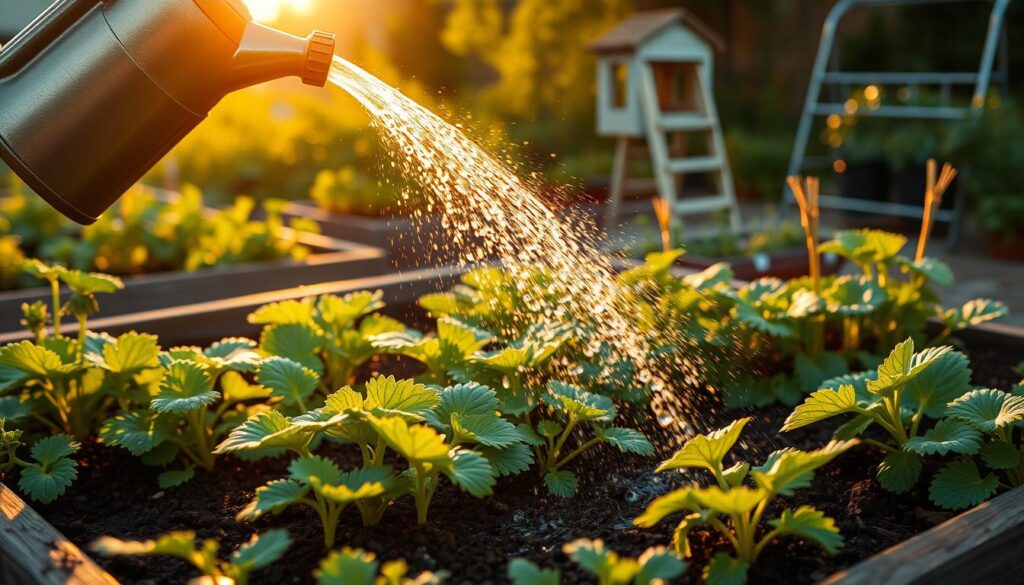
Customizing Your Raised Bed Garden
To make your small raised bed garden better, think about adding some custom touches. Use raised bed trellises for vertical gardening and pest control. These easy changes can turn your backyard into a beautiful garden.
Adding Trellises for Space-Saving Plant Support
Use trellises or cages in your raised beds for vertical gardening. They let you grow plants like tomatoes and beans upwards. This saves space and helps plants get more air and sunlight.
Protecting Plants from Unwanted Intruders
It’s important to keep pests away from your garden, especially in small spaces. Use row covers, netting, or cloches to block insects and birds. Also, try organic pest management and planting certain plants together to keep pests away without hurting good insects.
Extending the Growing Season
Raised beds can help you grow plants longer in small gardens. Add cold frames or hoop houses to protect plants from frost. This lets you plant earlier in spring and harvest later in fall. These methods make the most of your garden space all year.
“Incorporating vertical growing structures and pest-deterring methods can transform a small raised bed garden into a bountiful, space-efficient oasis.”
Conclusion
Creating a raised bed garden in a small backyard is a great way to make the most of limited space. These beds improve soil quality, help control pests and weeds, and make gardening easier. With the right planning and materials, even tiny backyards can grow fresh produce, herbs, and flowers.
With some effort and creativity, you can make your small outdoor area a lively, self-sustaining urban garden. The beauty of DIY gardening is you can customize your garden to fit your needs. You can add trellises, protect against pests, or grow plants all year.
Start enjoying the benefits of small backyard gardening with your raised bed garden. It can be a source of pride, relaxation, and healthy food for your family. Begin this rewarding journey and see how much you can do with your outdoor space.
FAQ
What are the benefits of raised bed gardening in small backyards?
Raised bed gardening is great for small yards. It lets you control the soil quality. It also helps prevent pests and weeds. Plus, it makes gardening easier on your back and joints.
How do I choose the right location for my raised bed garden?
Pick a spot that gets lots of sun all day and season. Stay away from areas that are always in the shade.
What size and number of raised beds should I have in a small backyard?
Keep each bed 8-10 feet long and 4 feet wide. Make sure there’s 28-36 inches between beds for paths. This makes it easier to move around.
What materials and tools do I need to build a raised bed garden?
You’ll need untreated lumber, hardware cloth or landscape fabric, and good potting mix or compost. Don’t forget a saw, drill, screwdriver, measuring tape, and gardening tools.
How do I level the ground before assembling the raised bed frame?
First, level the ground by digging or adding sand or gravel. This stops the bed from becoming uneven or unstable later.
What type of soil should I use to fill my raised beds?
Mix topsoil, compost, and organic additives for a rich soil blend. Avoid using soil from the ground to prevent problems.
How do I choose the right plants for my small raised bed garden?
Think about plant size, growth, and how they fit together. Use a mix of quick-growing crops, vines, and tall plants to use space well.
How do I maintain my raised bed garden in a small backyard?
Keep your garden watered, weeded, and fertilized as needed. Use drip irrigation and mulch to save water and fight weeds.
How can I extend the growing season in my small raised bed garden?
Use cold frames or hoop houses to protect plants from frost. These structures create warm spots for planting earlier and harvesting later.
Source Links
- How to Build a Raised Garden Bed: Step-by-Step Guide – https://homesteadandchill.com/how-to-build-raised-garden-bed/
- How to Build a Raised Garden Bed for Just $100 • Gardenary – https://www.gardenary.com/blog/how-to-build-a-raised-garden-bed-for-just-100
- How to Build a Raised Garden Bed – https://www.lowes.com/n/how-to/how-to-build-a-raised-garden-bed
The Best Vegetables for Small-Space Gardens: High-Yield Varieties You Need to Grow
Feeling limited by your small garden or growing space? Don’t let that stop you from enjoying a bountiful harvest! Discover the best vegetables to grow in compact areas. Maximize your yield, no matter the size of your outdoor oasis.
Key Takeaways
- Compact vegetable varieties thrive in small spaces and raised beds
- Container gardening opens up new possibilities for urban and balcony growers
- Leafy greens and root crops provide high yields in limited areas
- Space-saving tomatoes and peppers can be grown vertically
- Succession planting and companion planting techniques optimize your small garden
Maximizing Space in a Small Garden
Working with a small garden means picking the right plants. Choose compact vegetable varieties and use container gardening to make the most of your space. This way, you can grow a lot of food in even the smallest areas.
Compact Vegetable Varieties
For small gardens, try determinant tomatoes, bush beans, and small root vegetables like carrots and beets. These plants grow well in tight spaces and produce a lot. By picking these varieties, you can fill your garden space and get a big harvest.
Container Gardening Solutions
Container gardening is great for city gardeners. You can use patios, balconies, and small yards for growing. Use vertical gardening with trellises and hanging baskets for plants like tomatoes, peppers, and leafy greens. This way, you save space and grow a lot of food in a small area.
| Compact Vegetable Varieties | Container Gardening Techniques |
|---|---|
|
|
By using the right plants and container gardening, you can make your small garden very productive. You’ll get a lot of food, even with a tiny garden.
Best vegetables for small gardens
Small-space gardening means picking the right vegetables is key. Focus on high-yield, space-saving crops that do well in small areas. Leafy greens, root crops, tomatoes, peppers, and squash are great for small gardens.
Leafy greens like kale and Swiss chard are perfect for small gardens. They’re packed with nutrients and can be picked over and over. Compact root vegetables, such as carrots and beets, also do well in tight spaces, giving you a big harvest from a little space.
Tomatoes and peppers are excellent for small gardens too. Choose determinate or dwarf tomato varieties and compact pepper plants for a big crop without taking up much room. Squash is another great choice, fitting well in raised beds or containers.
To make the most of your small garden, pick the right vegetable varieties and use space-saving methods. Try vertical gardening and raised bed gardening. With some planning and the right choices, you can have a thriving garden even in a small space.
| Vegetable | Characteristics | Best Varieties for Small Gardens |
|---|---|---|
| Leafy Greens | Nutrient-dense, cut-and-come-again harvests | Kale, Swiss Chard |
| Root Crops | Compact growth, high yields | Carrots, Beets |
| Tomatoes | Prolific producers, space-saving varieties | Determinate, Dwarf |
| Peppers | Bountiful harvests, compact plants | Compact, Container-Friendly |
| Squash | High yields, versatile growing options | Bush, Patio |
Choosing the best vegetables for small gardens lets you enjoy a big harvest in a small space. Focus on high-yield, space-saving crops and use techniques like raised bed gardening to boost your productivity.
Leafy Greens for Cut-and-Come-Again Harvests
Leafy greens are perfect for small gardens. You can keep picking their leaves without pulling out the whole plant. This way, you get a steady supply of fresh, healthy greens from a small garden.
Kale: Nutrient-Dense and Prolific
Kale is a top pick among leafy greens. It’s packed with vitamins, minerals, and antioxidants. This tough plant does well in small spaces, giving you many harvests over a long season. Its big, pretty leaves make your garden look great too.
Swiss Chard: Vibrant and Versatile
Swiss chard is great for small gardens too. Its big, colorful leaves and crunchy stems add texture and taste to your meals. It’s perfect for salads or sautés, making your dishes look and taste amazing.
Adding these cut-and-come-again leafy greens to your garden means you’ll have fresh, tasty produce all season. Kale and Swiss chard are excellent for making the most of your garden space.
High-Yield Root Crops
Root vegetables are great for small gardens. They grow down, not out, making them perfect for tight spaces. Carrots and beets are top choices for small gardens.
Carrots: Sweet and Crunchy
Carrots are a favorite in small gardens. They fit well in shallow containers or raised beds. Varieties like ‘Parisian’ and ‘Nantes’ are made for small spaces.
Carrots are sweet, crunchy, and full of nutrients. They’re essential for any garden that saves space.
Beets: Nutritious and Flavorful
Beets are great for small gardens too. They give you tasty roots and leaves that are good for you. Beets come in many colors, like red, yellow, and striped.
Types like ‘Chioggia’ and ‘Bull’s Blood’ work well in containers or raised beds.
Choosing carrots, beets, or both can make your small garden very productive. You’ll get lots of tasty, healthy vegetables to enjoy.
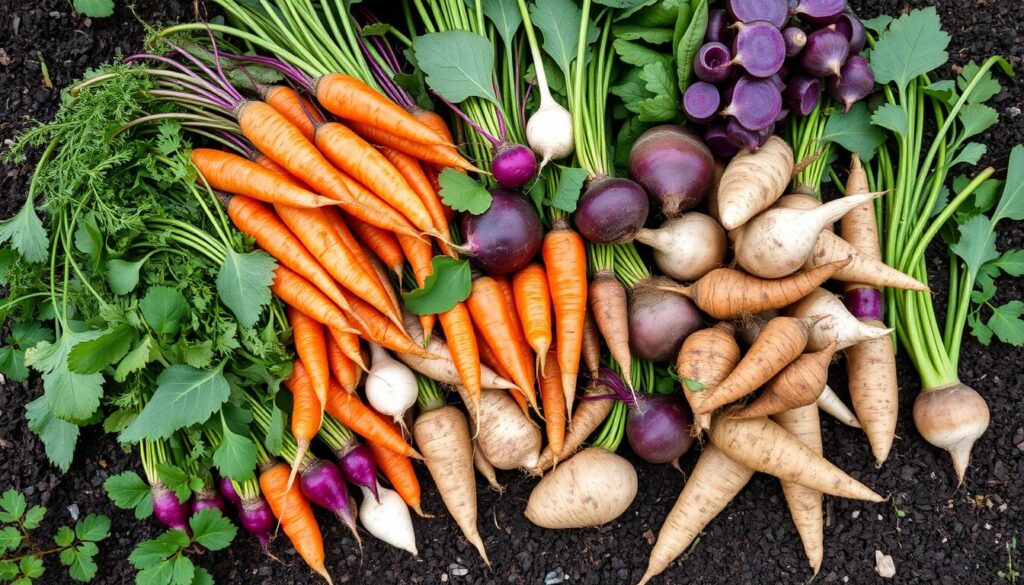
Space-Saving Tomatoes and Peppers
In small-space gardens, tomatoes and peppers are great choices. They grow well in small areas and give you lots of tasty produce. These space-saving crops are perfect for small gardens.
Determinate or “bush” tomatoes are great for containers and raised beds. They don’t spread out like some other tomatoes. Look for varieties like ‘Patio’, ‘Tiny Tim’, or ‘Tumbling Tom’ to save space.
Peppers are also great for small gardens. They come in many sizes, shapes, and colors. You can grow them in pots, hanging baskets, or small beds. Try ‘Redskin’, ‘Banana Supreme’, or ‘Miniature Bell’ for a small garden.
| Crop | Recommended Compact Varieties | Ideal Growing Conditions |
|---|---|---|
| Tomatoes |
|
|
| Peppers |
|
|
Choosing the right tomato and pepper varieties lets you have a big harvest in small spaces. These space-saving crops are perfect for small gardens. They grow well and offer many options.
Vertical Gardening Techniques
If you have limited gardening space, think about looking up. Vertical gardening lets you use your space well and grow more. You can use trellises for climbing plants and grow plants in hanging baskets.
Trellising Vining Crops
Vegetables like cucumbers, pole beans, and indeterminate tomatoes spread out a lot. By giving them a trellis to climb on, you save space and make picking easier. This method also helps with air flow.
- Build a strong trellis, fence, or teepee for the vines to climb on.
- Help the plants wrap their tendrils around the trellis as they grow.
- Pick vining plants that work well with trellises, like pole beans, cucumbers, and indeterminate tomatoes.
Hanging Baskets for Small Spaces
Using hanging baskets is another smart way to save space. You can grow plants like strawberries, cherry tomatoes, and herbs up high. This frees up space on the ground.
- Choose light, trailing plants for hanging baskets, such as strawberries, cherry tomatoes, and herbs.
- Use potting mix that drains well and make sure the baskets have holes for drainage.
- Put the hanging baskets in sunny spots that are protected from the wind.
With these vertical gardening tips, you can make the most of your small garden. You’ll get a lot of harvest even in small spaces.
Succession Planting for Continuous Harvests
To make the most of your garden, try succession planting. This means planting new crops where old ones have been picked. It keeps your garden always busy. By planting different vegetables at different times, you get fresh produce all season.
Succession planting is great for small gardens. It helps you use every inch of your garden well. With some planning and timing, you can have a lot of homegrown food from spring to fall.
- Begin with a planting calendar to plan your succession. Pick the crops you like and know when they mature.
- Plant quick-growing crops like lettuce, radishes, and spinach where early vegetables like peas or broccoli were.
- After picking the first crops, plant more seeds or transplants. This keeps your garden always growing and producing.
- Try different crops and planting times to find what works best for your garden.
With creativity and succession planting, your small garden can be full of continuous harvests. Use your space well and enjoy a full season of fresh vegetables from your garden.
Companion Planting for Pest Control
Gardening in small spaces can be tough, but smart strategies help. One great way is companion planting. This means growing plants together to help each other out. By picking the right plants, you can keep pests away and grow a healthy garden.
Marigolds and Nasturtiums: Natural Pest Deterrents
Marigolds and nasturtiums are top choices for keeping pests away. They make your garden look great and keep pests off your veggies and herbs. Marigolds keep aphids and spider mites away with their strong smell.
Nasturtiums also keep pests like aphids and whiteflies away. They grow around your veggies, making a barrier that pests don’t like. Plus, their bright flowers draw in good bugs that eat pests.
Using companion planting with marigolds and nasturtiums makes your garden better. You won’t need harsh chemicals or a lot of work. It’s a natural way to make your garden more productive and peaceful.
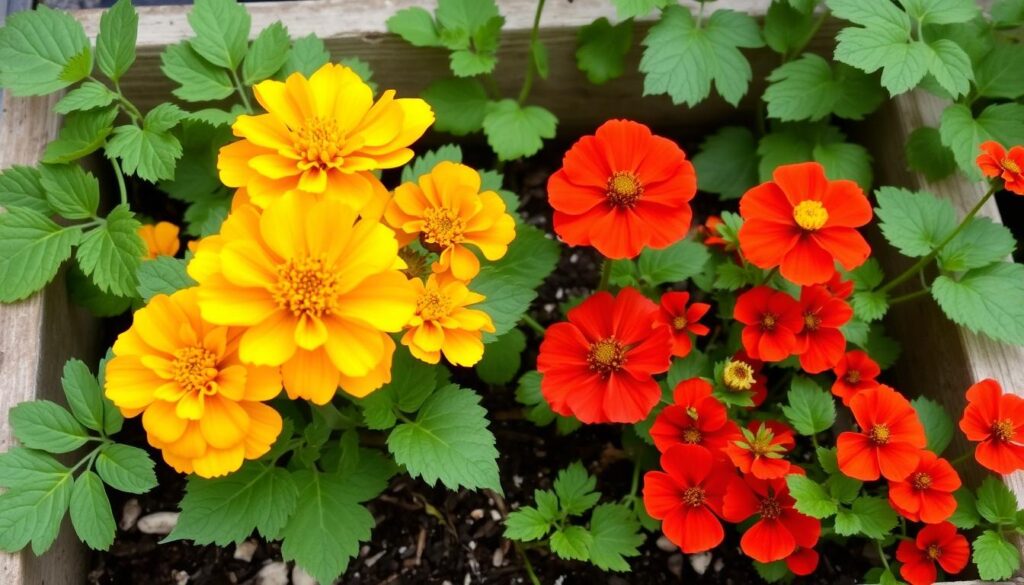
“Companion planting is a time-honored technique that allows gardeners to work with nature, not against it, to create a flourishing, low-maintenance garden.”
Conclusion
Choosing the right vegetable varieties and using smart space-saving methods can make your small garden thrive. You can grow everything from leafy greens and root vegetables to tomatoes and peppers in a small area. With some planning and creativity, even a tiny outdoor spot can become a garden full of fresh produce.
If you live in the city or have a small backyard, this article offers great tips for small gardens. It talks about growing vegetables in containers and using vertical gardening. You’ll learn about succession planting and companion planting to keep pests away. These methods can make your garden productive and full of life, even in a small space.
With the right techniques, even a tiny garden can be a success. Enjoy the benefits of urban gardening and taste the difference of eating your own fresh produce. It’s a great way to make the most of your outdoor space.
FAQ
What are the best vegetable varieties to grow in small gardens?
For small gardens, choose compact or determinate tomatoes, bush-type beans, and dwarf-sized root vegetables. Leafy greens like kale and Swiss chard are also great. Don’t forget space-saving crops like carrots and beets.
How can I maximize my limited garden space?
To make the most of your garden, try container gardening and vertical gardening. Use trellises and hanging baskets. Also, practice succession planting to keep your garden always productive.
What are some high-yield vegetables that thrive in small gardens?
Leafy greens, root crops, tomatoes, and peppers are great for small gardens. These varieties are compact and produce a lot. They can give you a big harvest even in a small space.
How can I use companion planting to control pests in my small garden?
Planting flowers and herbs like marigolds and nasturtiums with your vegetables can keep pests away. This is a natural way to protect your garden in a small space.
What techniques can I use to grow vegetables vertically in a small garden?
Try using trellises for vining crops and hanging baskets to grow vegetables up high. This way, you can use your space better and make the most of it.
How can I ensure a continuous harvest in my small garden?
Use succession planting to keep your garden full of fresh produce. Plant new crops in the spots where others have been harvested. This way, you’ll have a steady supply of vegetables all season long.
Source Links
- Most productive vegetables for limited space? – https://plantvillage.psu.edu/posts/4433-general-most-productive-vegetables-for-limited-space
- 14 Vegetables to Grow In A Small Garden – https://greensideup.ie/vegetables-to-grow-in-a-small-vegetable-garden/
- 17 High Yield Vegetables to Grow in Small Space Gardens – Gardeners’ Magazine – https://gardenersmag.com/high-yield-vegetables-to-grow-in-small-space-gardens/
Smart Vegetable Garden Layouts for Small Spaces: Maximizing Your Green Thumb in Compact Areas
Ever thought about turning a tiny backyard or balcony into a vegetable garden? Learn how to make the most of your small space. This article will show you how to use smart vegetable garden layout ideas to grow a lot in a little space. You can use even a small patio, courtyard, or plot to grow your own food.
We’ll cover everything from raised bed gardening and container gardening to vertical gardening and small border planting. These innovative methods will help you use your compact area well. This guide is full of useful tips and ideas to help you turn your small outdoor space into a productive vegetable garden. You’ll get to enjoy fresh, homegrown produce all year.
Introduction
Starting your small space vegetable garden is both exciting and rewarding. You can grow a garden even with a small balcony, patio, or backyard. This article will show you how to make the most of your space for a beautiful and productive garden.
Small-space gardening offers many innovative ways to make the most of limited areas. You’ll learn about the best plants and layouts for your garden. This guide will give you the skills and ideas to use your space well.
Get ready to enjoy growing your own food, herbs, and flowers. You’ll also make your outdoor space look better. Let’s start exploring how to create a great vegetable garden in a small space!
Understanding Your Space
Creating a small vegetable garden starts with knowing your space well. Whether it’s a balcony, patio, or backyard, look closely at what you have. This will help you use your very small garden ideas on a budget wisely.
Assessing Available Space
First, measure your outdoor area. This tells you how much space you have. It helps you pick the best vegetable gardening ideas for small spaces. Even tiny areas can become great gardens.
Identifying Sunlight and Shade
Then, check how the sun hits your space. Find out where it shines fully, partly, or not at all. This info helps you choose the right vegetable gardening supplies for your plants.
Soil Quality and Preparation
Good soil is key for a raised bed vegetable gardening for beginners. If your soil is bad, add compost or use a raised bed with good soil. Good soil is vital for your garden to do well.
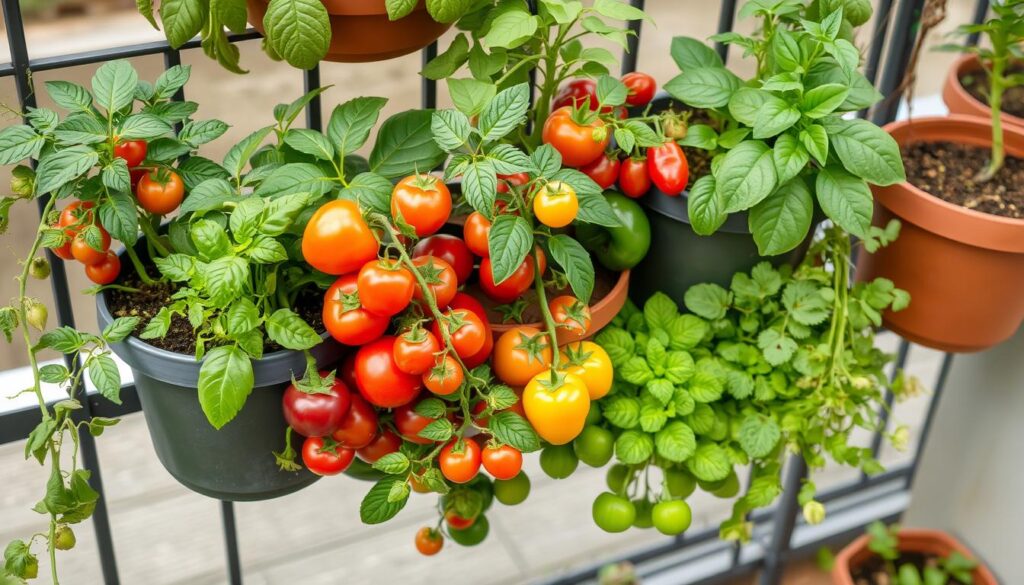
“The secret to a thriving small-space vegetable garden lies in understanding the unique characteristics of your available area.”
Choosing the Right Layout for Your Space
For small-space vegetable gardening, the layout is key. You can use raised beds, containers, or vertical solutions. These options help you make the most of your space and grow a great vegetable garden layout for small spaces.
Raised Bed Gardening
Raised bed vegetable gardening for beginners is great for small areas. It lets you control the soil and plant more densely. Use materials like cedar, hemlock, or corten steel for your raised beds. Fill them with a mix of garden soil and compost for good drainage and early warming.
Container Gardening
If you don’t have much ground space, container gardening is a good choice. You can grow veggies in pots, windowboxes, or hanging baskets. Choose containers with good drainage and use a light, draining potting mix for your small vegetable garden layout.
Vertical Gardening
Using vertical space is smart for very small garden ideas on a budget. Grow plants like cucumbers and tomatoes on trellises or fences. This saves space and reduces pests and diseases by keeping plants off the ground.
Small Border Planting
If you’re short on space but want to garden, try small border plants for landscaping. Use compact veggies like leaf lettuce and parsley between other plants. Or mix food crops with flowers in containers.
By trying out these vegetable garden layout plans and spacing ideas, you can make the most of your small space. Enjoy a big harvest of fresh produce from your garden.
Selecting the Right Plants for Small Spaces
For small-space vegetable gardens, pick plants that are compact and produce a lot. Look for “bush,” “dwarf,” or “patio” types made for containers or small areas. Plants like ‘Micro Tom’ tomatoes, ‘Mascotte’ bush beans, and ‘Katarina’ mini cabbages are great for small spaces. They give you a big harvest without taking up much room.
Compact and High-Yield Varieties
It’s important to choose compact and high-yielding vegetables for small gardens. These plants are made to give a lot of food without needing a lot of space. By picking these, you can have a wide variety of garden vegetables list in tiny spaces.
Companion Planting
Companion planting is a smart way to garden in small spaces. It means growing different plants together to keep pests away, improve soil, and increase food. For example, growing fast plants like lettuce with slow-growing tomatoes makes the most of your space.
Seasonal Planting Strategies
Make the most of each season in a small garden. Use succession planting to follow one crop with another in the same spot. After spring crops are gone, add summer plants like bush beans, zucchini, or cucumbers. This vegetable garden layout for small spaces keeps your garden busy all year.

By picking the right plants, using companion planting, and planting at the right times, you can make the most of your small vegetable gardening ideas for small spaces. This way, you’ll get a big harvest from your garden.
Essential Gardening Supplies for Small Spaces
When you’re working with limited space, having the right vegetable gardening supplies is key for a successful small vegetable garden. Choose compact, space-saving tools to make the most of your area. Tools like mini hand trowels and collapsible garden carts are great for raised bed vegetable gardening for beginners or vegetable gardening ideas for small spaces.
Tools and Equipment
- Mini hand trowel for tight spaces
- Compact pruning shears for precise trimming
- Collapsible garden cart or wagon to transport supplies
- Vertical supports like trellises, cages, or stakes for climbing plants
Soil and Fertilizers
Make sure your small vegetable garden layout has rich soil by adding high-quality compost or organic fertilizer. For container gardening, use a potting mix made for vegetables. Adding compost or slow-release fertilizer often will keep your plants healthy and productive in small spaces.
Watering Systems
Proper watering is key for your vegetable gardening supplies. Choose systems like drip irrigation or soaker hoses to water plants directly and save water. For containers, use self-watering planters or a simple watering schedule to avoid too much or too little water.
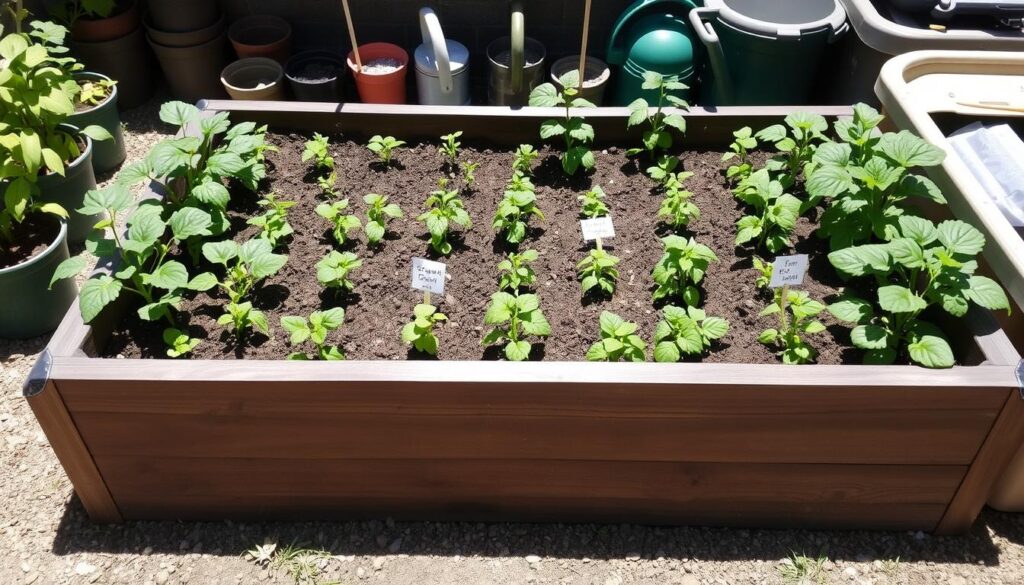
“With the right vegetable gardening supplies and creativity, you can turn even the smallest spaces into a thriving small vegetable garden.”
Budget-Friendly Tips for Small Space Gardening
Gardening in a small space on a tight budget is doable with creativity and resourcefulness. By using DIY projects, upcycling, and finding affordable supplies, you can make your small garden thrive. You won’t have to spend a lot of money.
DIY Garden Projects
Get creative and show off your DIY skills. Use items like plastic containers, wooden pallets, or old gutters to make planters and vertical gardens. These homemade items save money and make your garden stand out.
Upcycling and Repurposing
Try upcycling and repurposing to decorate your small vegetable garden layout. Turn old tires, buckets, or washing machine drums into planters. These upcycled items are good for the planet and add personality to your garden.
Sourcing Affordable Supplies
When setting up your vegetable gardening supplies for a raised bed vegetable gardening for beginners setup, find affordable sources for things like soil, seeds, and seedlings. Look at local garden centers, home improvement stores, or online for sales. Also, check out community seed exchanges or swap programs for cheaper, quality plants.
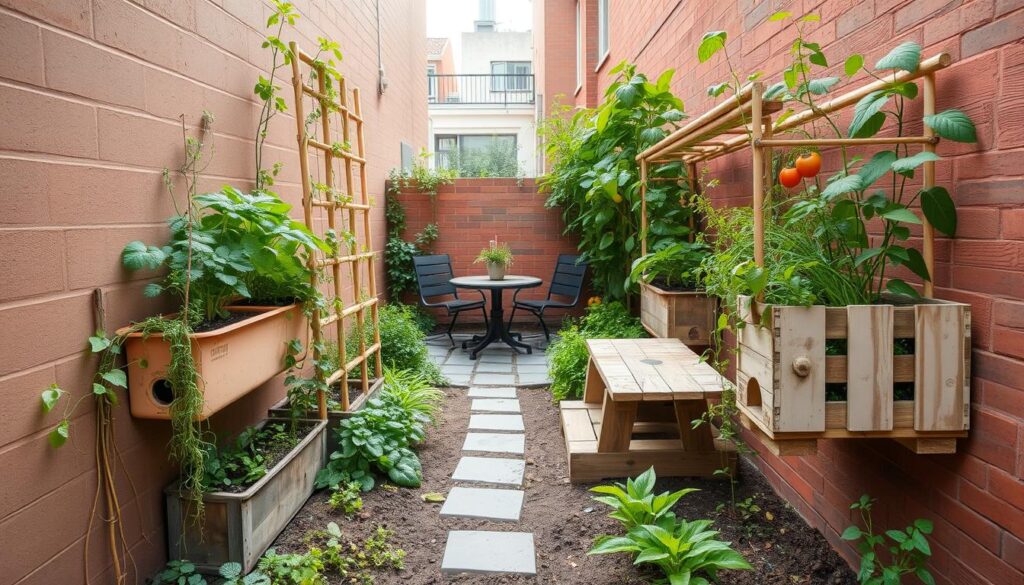
“Embrace the art of upcycling and repurposing to furnish your small vegetable garden layout.”
Vegetable Garden Layout Plans and Spacing
Creating a good layout plan is key for a small vegetable garden. Think about the size and growth of your plants. Place taller plants like tomatoes or pole beans at the back. This lets shorter plants like lettuce or radishes grow well in front.
Creating a Layout Plan
When planning your garden, focus on the right spacing for each plant. Check seed packets or plant tags for spacing advice. This helps avoid crowding, ensures good air flow, and lets your veggies grow well.
Optimal Spacing
- Tomatoes: 24-36 inches between plants, 36-48 inches between rows
- Carrots: 1-2 inches between plants, 12-18 inches between rows
- Lettuce: 8-12 inches between plants, 12-18 inches between rows
- Zucchini: 24-36 inches between plants, 36-48 inches between rows
Example Layouts
Look at example layouts to get ideas for your small garden. You can find plans for raised beds, containers, vertical gardens, and mixed borders. Use these ideas to make a layout that fits your space and goals.
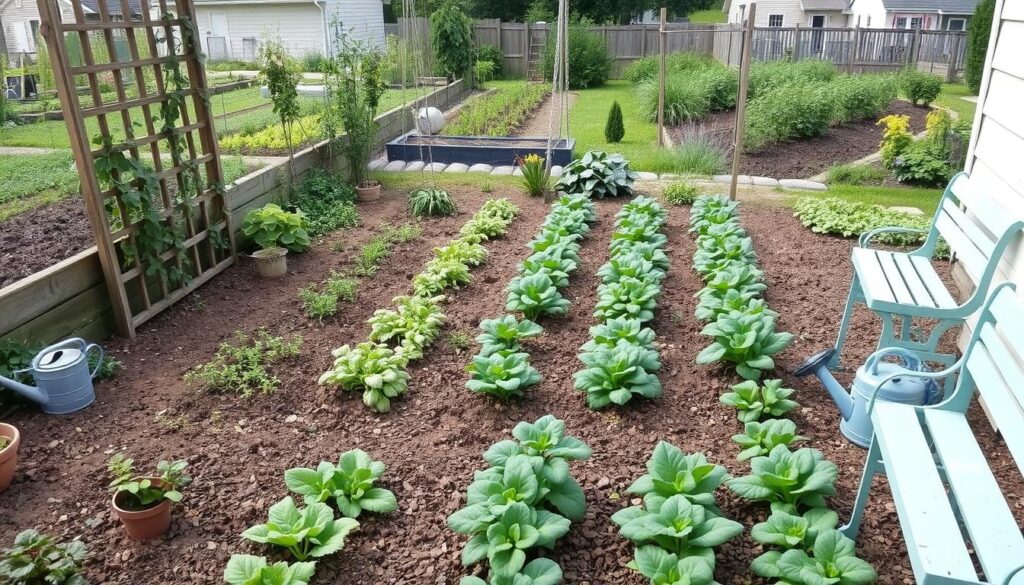
Plan your garden’s layout and spacing well to make the most of your space. This way, you can enjoy a lot of fresh, homegrown produce.
Conclusion
This article has shown you how to make your small outdoor space a great place for vegetable gardening ideas for small spaces. You learned how to pick the right plants and arrange them well. This guide has given you the tools to make the most of your small garden.
Even tiny spaces can produce a lot of vegetables with creativity and hard work. You can use raised beds, containers, or vertical gardening. These methods offer many ways to garden in small areas. Take on the challenge and watch your garden grow in your small outdoor space.
Enjoy your gardening and harvesting! Let your small-space garden give you fresh, healthy food and the happiness of growing your own plants.
FAQ
What are some clever vegetable garden layouts for small spaces?
We explore ways to save space, like raised beds, containers, vertical gardens, and small borders. These methods help turn small areas into productive gardens.
How can I maximize my yields in a small vegetable garden?
Choose plants that grow well in tight spaces and produce a lot. Use companion planting and succession planting to fill your garden fully.
What are the key considerations when planning a small-space vegetable garden?
First, check the space you have. Look at where the sun shines and make sure the soil drains well and has the right nutrients for your plants.
What are the benefits of raised bed gardening for small spaces?
Raised beds let you control the soil and pack more plants in. They also drain well and warm up faster, helping your plants grow.
How can I incorporate vegetables into a small landscape?
Try small border planting, mixing veggies with flowers or other plants. Or, put compact veggies in containers with your flowers.
What are some budget-friendly tips for small-space vegetable gardening?
Go for DIY projects and reuse items you have at home. Look for affordable seeds, seedlings, and soil to save money.
How do I create an efficient layout for my small vegetable garden?
Plan your garden carefully. Think about how big your plants will get and how far apart they should be. Arrange them to use your space well.
Source Links
- Small Vegetable Garden Ideas – https://www.gardengatemagazine.com/articles/vegetables/edible-plant-guide/small-vegetable-garden-ideas/
- 52 small garden ideas – tiny, fabulous designs to copy in your outdoor space – https://www.realhomes.com/design/small-garden-ideas
- Maximizing Small Spaces: Landscape Design Ideas for Compact Gardens – https://www.needforbuild.com/maximizing-small-spaces-landscape-design-ideas-for-compact-gardens/
40. Best Practices for Managing a Sustainable Garden Year-Round
Imagine a garden that grows well without using up too many resources or hurting the planet. With the right sustainable gardening tips, you can make your garden a self-sustaining place. It will need little upkeep and help you garden more efficiently. But, where do you begin? How can you keep your garden looking great all year?
This guide will show you the best ways to manage a sustainable garden all year. You’ll learn about planning, planting, controlling pests, and preserving your garden. Discover how to create an eco-friendly garden that feeds your family and helps the environment. Get ready to learn the secrets of sustainable gardening and see your garden flourish like never before.
Key Takeaways
- Use sustainable gardening methods to lessen your environmental impact and improve soil health.
- Plan your garden with native, diverse plants that support local ecosystems and need fewer resources.
- Use water wisely and compost to cut down on waste and increase efficiency.
- Control pests and weeds naturally, avoiding harmful chemicals and boosting biodiversity.
- Buy your gardening supplies locally to support your community and lower transportation emissions.
Benefits of Sustainable Gardening
Sustainable gardening is more than just growing plants. It helps the environment and makes your garden healthier. By using eco-friendly methods, you can lessen your impact on the planet and boost your plants’ health.
Reducing Environmental Impact
By gardening sustainably, you can cut down on your carbon footprint and save natural resources. Composting turns waste into food for your soil, keeping it rich and fertile. Using less water and choosing plants that don’t need much water also helps save this vital resource.
Choosing not to use harmful chemicals keeps your garden and the environment safe. This creates a better place for all living things.
Improving Soil Health
Healthy soil is key in sustainable gardens. Adding compost and cover crops makes your soil better for your plants. This leads to stronger, healthier plants that can handle your local weather.
Healthy soil also means more good bugs and worms, which helps your garden cycle nutrients naturally. This makes your garden a better place for plants to grow.
| Sustainable Gardening Benefit | Impact |
|---|---|
| Reduced Environmental Impact |
|
| Improved Soil Health |
|
“Sustainable gardening is not just about growing plants – it’s about nurturing the entire ecosystem, from the soil to the wildlife that call your garden home.”
Planning Your Sustainable Garden
Starting a sustainable garden means planning carefully. First, think about what you want from your garden. Do you want to grow food, help pollinators, or make a beautiful space? After deciding, pick a variety of native plants that fit your local climate and soil.
Defining Your Gardening Goals
Think about what you want from your garden. Do you aim to grow your own food or help local wildlife? Knowing your gardening goals helps pick the right plants and designs.
Choosing Native and Diverse Plants
Native plants are perfect for your area because they need less water and food. Using many native plants makes your garden strong and full of life. Think about your garden’s sunlight and soil to pick the best plants.
“Sustainable gardening is not just about the plants you choose, but the entire ecosystem you create. By focusing on native species and promoting biodiversity, you’ll witness your garden come alive with vibrant colors, buzzing insects, and joyful birdsong.”
Garden planning and sustainable garden design work together. Set your goals and choose the right native plants for a beautiful, eco-friendly garden.
Sustainable Gardening Techniques
Sustainable gardening is all about making your garden better for the planet and for you. It’s about composting and saving water. These two things are key for a green garden.
Composting Organic Waste
Composting is a big deal in sustainable gardening. You turn food scraps, yard clippings, and leaves into soil that feeds your plants. It cuts down on landfill waste and makes soil healthier. This means your plants grow better and you use fewer chemicals.
Water Conservation Methods
Water is precious, and saving it is important in gardening. Using rain barrels and mulch helps you use less water. Watering in the cool hours also helps. These methods keep water around for your plants and protect our environment.
| Sustainable Gardening Technique | Benefits |
|---|---|
| Composting Organic Waste |
|
| Water Conservation Methods |
|
Using these sustainable gardening tips, you can make a garden that’s good for the earth and for you. It’s a win-win for everyone.
Managing Pests and Weeds Naturally
As a sustainable gardener, you aim to make a garden that works with nature. You look into natural pest control and organic weed management instead of harsh chemicals. Using eco-friendly gardening methods helps keep your garden healthy and your food safe.
One good way to control pests and weeds is with physical barriers. Use row covers or mesh to keep pests away from your plants. These barriers let air, light, and water in but keep pests out. You can also bring in ladybugs, which eat many garden pests.
For weeds, try organic mulches to stop them from growing. Mulch blocks sunlight and stops weed seeds from sprouting. Pulling weeds by hand is another great way to keep your garden clean.
| Natural Pest Control Methods | Organic Weed Management Techniques |
|---|---|
|
|
Using these natural pest control and organic weed management methods makes a garden that’s good for the environment. Your plants will be healthier, your soil richer, and your harvest will be safe and plentiful.
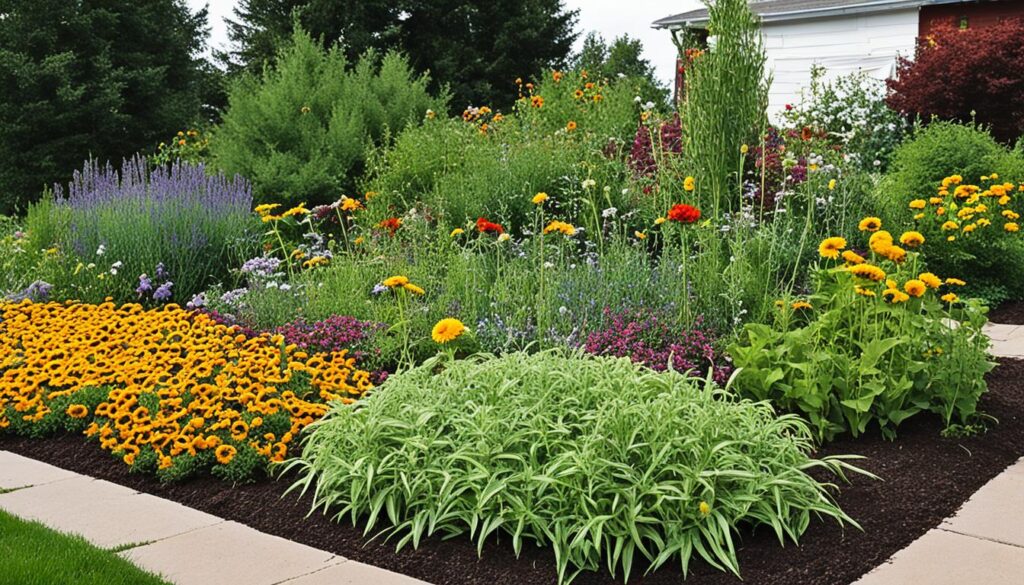
Sourcing Supplies Locally
When planning your sustainable garden, think about getting your supplies from local places. Buying plants, seeds, and other items from nearby nurseries, garden centers, and farmers’ markets helps your community. It also cuts down on the harm caused by transporting goods over long distances.
Supporting Local Growers
Local plants fit well with your area’s weather and soil, making them more likely to thrive in your garden. Buying from local spots also boosts your community’s economy. It encourages gardening that is good for the planet.
Reducing Transportation Emissions
Getting your gardening stuff closer to home means less carbon emissions from transport. This is key to sustainable gardening. It helps make your garden’s impact on the environment smaller.
| Benefit | Description |
|---|---|
| Adapt to local conditions | Plants sourced locally are often better suited to your region’s climate and soil, leading to higher success rates. |
| Support community growers | Purchasing from local nurseries and farmers’ markets helps to strengthen your community’s economy and promote sustainable gardening. |
| Reduce emissions | Minimizing the transportation distance of your gardening supplies lowers the carbon footprint associated with their delivery. |
Trying to get your garden supplies from local places makes your gardening more sustainable. It helps your community and cuts down on carbon emissions from transport. This is good for the planet and supports eco-friendly gardening.
Encouraging Biodiversity
Sustainable gardening means creating a thriving ecosystem in your yard. By encouraging biodiversity, you draw in helpful insects and animals. These creatures help control pests and support your eco-friendly gardening goals.
Attracting Beneficial Insects and Wildlife
To attract beneficial insects, plant native flowers, herbs, and shrubs. These plants offer food and shelter to local wildlife. Also, leave some areas wild to support diverse habitats.
Creating Habitats for Native Species
Creating wildlife habitats helps the local ecosystem and lets you watch the wildlife up close. Provide nesting sites for birds and leave leaves and branches for small mammals. This sustainable landscaping makes your garden a haven for many species.
“A garden is a grand teacher. It teaches patience and careful watchfulness; it teaches industry and thrift; above all it teaches entire trust.” – Gertrude Jekyll
Year-Round Sustainable Gardening
Sustainable gardening is a year-round effort. It’s about keeping your garden healthy, productive, and good for the planet. Using crop rotation and succession planting helps your garden work better and cuts down on the need for extra help.
Crop Rotation and Succession Planting
Move your vegetable crops around the garden each year to stop diseases and pests. This crop rotation keeps the soil healthy and breaks up the life cycles of pests. Then, use succession planting to plant new crops where the old ones were. This way, you get a steady harvest all season long.
Extending the Growing Season
Find ways to make your growing season last longer. Use cold frames or greenhouses to start seeds early and protect plants. These eco-friendly gardening practices let you enjoy your garden all year.
“The true essence of sustainable gardening lies in its ability to provide nourishment and delight throughout the year, while respecting the delicate balance of nature.” – Gardening Enthusiast
Harvesting and Preserving Your Produce
As your sustainable garden grows, you’ll get a lot of tasty, healthy produce. It’s key to handle the harvest well and learn how to preserve food. This way, you can use more of your garden’s food and make the most of it.
Sharing Your Harvest
Sharing your garden’s extra food is a big reward of sustainable gardening. Think about giving your extra veggies and fruits to local food banks or sharing with neighbors and friends. This helps fight food insecurity and builds community around gardening.
Preserving Techniques
To keep enjoying your garden’s flavors even when it’s not growing season, try eco-friendly ways to preserve food. Canning, freezing, and drying are great for keeping your garden’s produce fresh. Try different methods to see what works best for you.
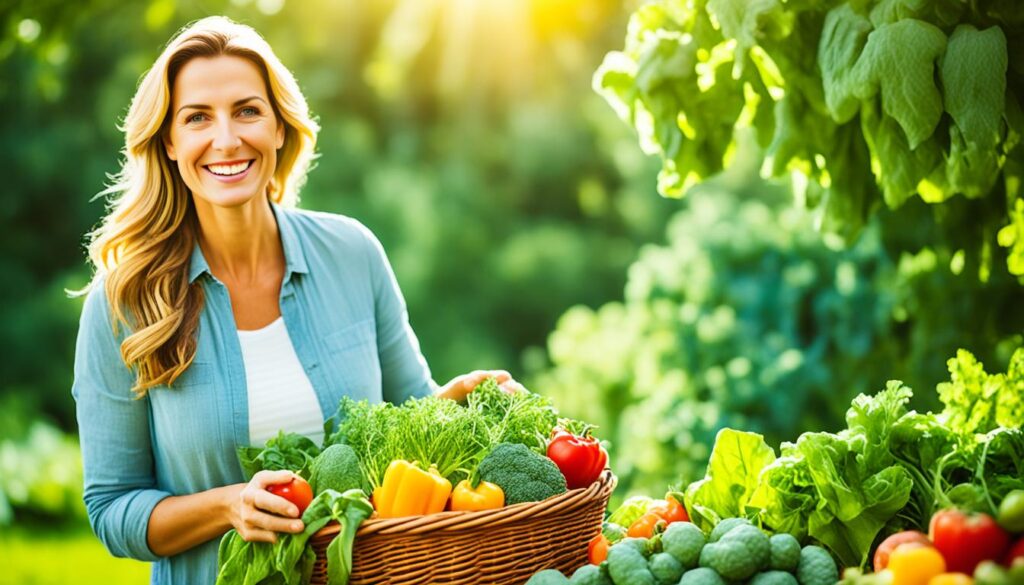
By harvesting sustainable garden produce, sharing your garden harvest, and preserving garden produce with eco-friendly food preservation methods, you can enjoy your sustainable gardening practices all year. This way, you get to enjoy your garden’s fruits for longer.
Building a Community Around Sustainable Gardening
Sustainable gardening is more than just a hobby; it’s a way to help our communities and the planet. Look for or start local gardening groups, clubs, or online forums. These places let you share tips, swap plants, and work on projects together. By joining forces with others, you can learn, solve problems, and spread eco-friendly gardening ideas in your area and beyond.
Being part of a sustainable gardening community is very rewarding. You’ll get helpful advice and support. Plus, you can help your local environment in many ways. You might start a composting program, host seed swaps, or work with schools to create gardens.
Building a community around sustainable gardening brings people together. You can make a bigger impact by working as a team. You can push for policies that help eco-friendly gardening networks and community-based sustainable practices. This could mean pushing for more garden spaces or teaching how to save water.
“The best way to predict the future is to create it.” – Peter Drucker
If you’re into gardening or just starting, reach out to your local gardening groups. Let’s work together to make our communities and planet greener.
Conclusion
Embracing sustainable gardening is a rewarding way to make your outdoor space better for the planet. By following the best practices, you can lessen your environmental impact. You’ll also improve soil health, attract beneficial wildlife, and enjoy a harvest all year.
Sustainable gardening is a journey that never stops. Keep learning, trying new things, and adjusting your methods. This way, you can create a garden that’s strong and helps both you and the environment.
There are many benefits to sustainable gardening. It helps reduce your carbon footprint and creates a diverse ecosystem in your yard. By using the strategies from this article, you’ll get a garden that’s full of life and beauty. You’ll also help protect the environment for the future.
FAQ
What are the benefits of sustainable gardening?
Sustainable gardening helps the environment and your garden. It reduces your carbon footprint, improves soil health, and makes your outdoor space eco-friendly.
How do I plan a successful sustainable garden?
Start by setting clear gardening goals. Choose a variety of native plants. Use composting and water wisely.
What are some sustainable gardening techniques I can use?
Use composting, water-saving methods, and natural pest control. These techniques help your garden grow sustainably.
How can I source supplies locally for my sustainable garden?
Buy plants, seeds, and materials from local nurseries, garden centers, and farmers’ markets. This supports local growers and cuts down on transportation emissions.
How can I encourage biodiversity in my sustainable garden?
Plant native flowers, herbs, and shrubs to attract beneficial insects and wildlife. Create diverse habitats in your garden for more biodiversity.
What are some year-round sustainable gardening practices I can implement?
Use crop rotation and succession planting to make your garden more efficient. Try cold frames or greenhouses to grow food all year.
How can I make the most of my sustainable garden’s harvest?
Share your garden’s produce with neighbors and local food banks. Learn to can, freeze, and dry food to enjoy your harvest longer.
How can I build a community around sustainable gardening?
Join or create local gardening groups, clubs, or online forums. Share knowledge, swap seeds, and work together on sustainable projects.
Source Links
- https://platthillnursery.com/sustainable-garden-ideas-for-a-more-eco-friendly-space/ – Eco-Friendly Gardening in Chicago — Platt Hill Nursery, Chicago
- https://www.motherearthnews.com/organic-gardening/gardening-tips-zm0z11zsto/ – 40 Backyard Vegetable Gardening Tips to Maximize Your Harvest – Mother Earth News
- https://www.anspblog.org/seven-steps-to-sustainable-gardening/ – Seven Steps to Sustainable Gardening
Building a Wildlife Pond for Biodiversity
Are you ready to make your backyard a thriving ecosystem? A wildlife pond could be the perfect choice. By adding a natural water feature, you’ll attract many species and boost your garden’s biodiversity. But what makes a wildlife pond different from a regular pond? Let’s dive into the world of these eco-friendly water features and see their benefits.
Key Takeaways
- Wildlife ponds create a habitat for a diverse range of species, supporting biodiversity in your garden.
- These natural water features require minimal maintenance, making them a sustainable and eco-friendly addition to your outdoor space.
- Unlike ornamental ponds, wildlife ponds focus on providing a natural environment for plants and animals, rather than aesthetic appeal.
- By incorporating a wildlife pond, you can transform your backyard into a thriving ecosystem that supports pollinators, birds, and other beneficial wildlife.
- Building a wildlife pond is a rewarding project that can enhance the overall health and vibrancy of your garden’s ecosystem.
What is a Wildlife Pond?
A wildlife pond is a special place above ground that helps many different kinds of animals. It’s not just for looks; it’s a home for birds, insects, amphibians, and more. This pond gives them food, water, and a safe place to live.
Benefits of a Wildlife Pond
Having a wildlife pond brings many advantages:
- It draws in lots of native plants and animals to your yard
- It supports a healthy aquatic ecosystem with its natural features
- It’s a beautiful, easy-care natural water feature for your outdoor area
Difference from Ornamental Ponds
Unlike ornamental ponds, which often have exotic plants and fish, a wildlife pond is made to be self-sufficient. It’s a balanced home for nature. Ornamental ponds don’t help support a diverse wildlife habitat like a wildlife pond does.
“A wildlife pond is a thriving, self-sustaining haven that brings the beauty of nature right to your doorstep.”
Choosing the Right Location
Choosing the right spot for a wildlife pond is key. Don’t put it in the front yard where kids might get hurt. Instead, pick a spot in your backyard or side garden that gets some shade. This garden placement keeps the pond cool for animals on hot days and stops algae growth.
Think about keeping kids safe too. Put your pond where it’s not in the way of where kids play. This way, kids stay safe and nature gets a home. A good pond spot can make your outdoor area special. It lets you and your family enjoy the wildlife accessibility and the peaceful sound of water.
“The perfect location for your wildlife pond is one that balances safety, sun exposure, and accessibility for the creatures you hope to attract.”
Look for spots that get some shade all day. This keeps the water temperature steady and makes it better for animals. Also, pick a place you can easily get to for upkeep, but not too close to where people walk by a lot.
By picking the right spot for your pond, you make a beautiful outdoor space. You also give a safe place for plants and animals to live.
Container Options for Your wildlife pond
Choosing the right container for your wildlife pond is key. It should be at least 18 inches wide and 5-8 inches deep. This size lets native aquatic plants grow well. You can use recycled containers that work great for this purpose.
Repurposed Firepits and Tubs
Old metal tanks, utility tubs, and repurposed firepits can become beautiful wildlife ponds. They are strong, won’t leak, and are perfect for your backyard. They help native plants grow and are safe for local wildlife.
Lining Porous Containers
If your container is made of porous materials like concrete or clay, line it with a good pond liner. This stops leaks and keeps the pond clean. It makes sure your pond is a safe place for wildlife.
Picking the right container and waterproofing it well makes a great wildlife pond. It will draw in many local species and boost your outdoor area’s biodiversity.
| Container Type | Advantages | Considerations |
|---|---|---|
| Metal Stock Tanks |
|
|
| Repurposed Firepits |
|
|
| Utility Tubs |
|
|
“The key to a successful wildlife pond is finding the right container that can safely and securely hold water while supporting the growth of native aquatic plants.”
Selecting Native Plants
Creating a thriving wildlife pond means picking native aquatic plants. These plants are key to the pond’s biodiversity. They feed, shelter, and give oxygen to many species you want to attract.
But, be careful with non-native and invasive species. They can upset the pond’s balance. Choose native plants that fit your area well. This ensures a pond that’s in harmony with local wildlife.
Importance of Native Aquatic Plants
Native aquatic plants are crucial for a healthy wildlife pond. They feed many creatures, from insects to birds. They also give cover and shelter, helping young ones grow.
These plants are key to keeping the water oxygenated. This keeps the aquatic ecosystem healthy. By picking these plants, you help create a pond that looks after itself and supports many native species.
Avoiding Invasive Species
It might be tempting to try exotic plants, but avoid invasive species in your wildlife pond. They can crowd out native aquatic plants, harming the biodiversity you’re trying to keep.
Talk to local experts or a trusted nursery to pick the right plants. They can guide you to plants that do well in your area and support your pond’s biodiversity.
What Not to Include in a wildlife pond
Creating a wildlife pond means avoiding the urge to add ornamental features. Unlike decorative ponds, a wildlife pond doesn’t need fish, filters, or chemicals. These can harm the wildlife you’re trying to help.
No Fish or Filtration Needed
Koi and goldfish eat native plants and animals, reducing biodiversity. Filters and aeration systems are also not needed. They can harm the delicate water environment. Let your wildlife-friendly design work naturally without adding ornamental features or chemical-free treatments.
“The best wildlife ponds are those that mimic nature, allowing the ecosystem to establish itself organically without human interference.”
Keep your pond simple and free from chemicals. This creates a home for many native species, like dragonflies, frogs, birds, and small mammals. Enjoy the natural beauty and balance of your wildlife-friendly pond.
Filling and Establishing Your wildlife pond
When filling your wildlife pond, think about the water sources. Use collected rainwater if you can, as it’s natural and free from chemicals. If not, let tap water sit for a few days to lose chlorine and additives.
Pay attention to the substrate as you fill the pond. Use soil, turf, or flagstones to cover the edges. This stops sunlight from breaking down the substrate and keeps it from mixing with the water. It’s good for the pond’s ecosystem.
Getting native plants to grow in your pond takes time, but it’s worth it. These plants are key for feeding and sheltering the pond’s wildlife. With patience, your pond will become a lively ecosystem.
| Water Sources | Substrate Management | Plant Establishment |
|---|---|---|
| Rainwater collection | Backfilling edges with soil or turf | Patience and time for native plants to thrive |
| Allowing tap water to sit for dechlorination | Preventing substrate dispersion | Essential for creating a balanced ecosystem |
Think about the water, substrate, and plants when setting up your wildlife pond. Doing so will help create a thriving pond that draws in many species. It will also give you hours of joy and a chance to connect with nature.

“The creation of a thousand forests is in one acorn.” – Ralph Waldo Emerson
This quote shows how a small, well-made pond can become a lively place for many species. With the right care, your pond will show the beauty and strength of nature.
Attracting Wildlife to Your Pond
After making your pond, it’s time to make it a hotspot for local species. Add habitat features to turn your pond into a lively spot. This will draw in frogs, dragonflies, birds, and small mammals.
Creating Cover and Shelter
It’s key to offer plenty of cover and shelter for a wildlife community. Think about adding these to make your pond a cozy habitat:
- Shallow spots along the pond’s edge for easy movement
- Placing rocks, logs, or branches for shelter and perches
- Emergent plants like cattails, rushes, and water lilies for cover
These elements make your pond more welcoming. They’re also vital for the biodiversity of your pond. They provide safe spots, nesting places, and perches for many species. This helps your pond become a balanced and lively place.
“A well-designed wildlife pond becomes a magnet for a diverse array of local species, transforming your backyard into a vibrant, living ecosystem.”
By picking the right habitat features for your pond, you’ll draw in many interesting wildlife. Your backyard will become a lively oasis.
wildlife pond Maintenance
Having a low-maintenance wildlife pond means you can let nature do its thing. Unlike fancy water features that need constant care, your pond will do well with natural processes. These processes keep the water clean and plants healthy. Try not to mess with it too much, as this can upset the pond’s balance.
Go for a hands-off approach and watch your pond grow. Just take out any big trash now and then, but let the plants and animals be. This way, your pond becomes a lively place that takes care of itself with little work from you.
By sticking with the low-maintenance side of your pond, you get to see its beauty and the variety of life it supports. It shows how powerful natural processes are. And it proves that a hands-off way of caring for your pond can lead to a lively, self-sustaining environment in your yard.
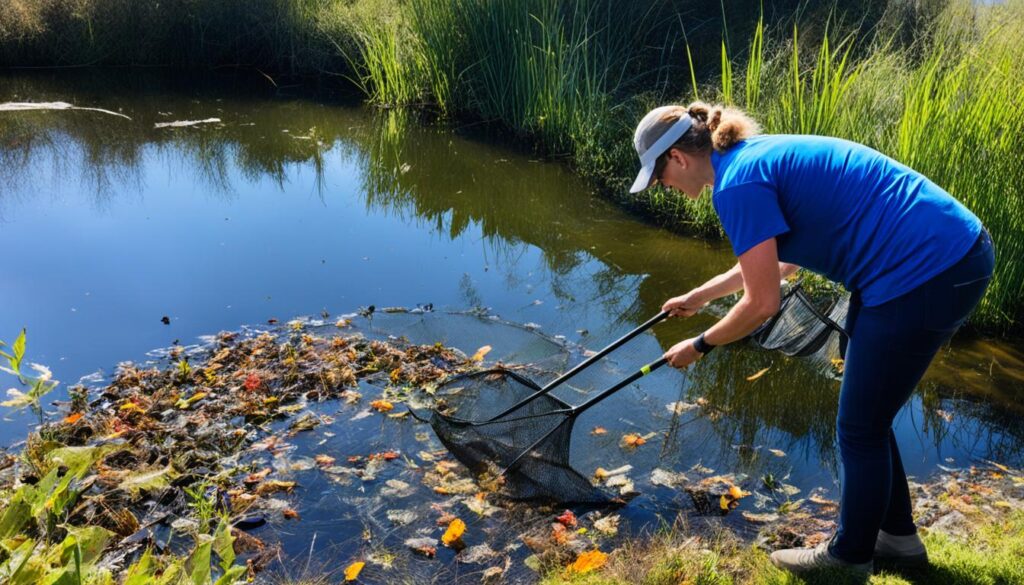
“The true beauty of a wildlife pond lies in its ability to thrive on its own, without the need for constant human intervention.”
Best Time to Build a wildlife pond
Creating a thriving wildlife pond depends on the right timing. Late summer or early fall is best. This lets plants grow strong roots and frogs find the pond before breeding starts.
If you can’t start in late summer, don’t worry. You can still make a great wildlife pond. Many species might still find and love it, even if it’s not the perfect time.
“The best time to plant a tree was 20 years ago. The second best time is now.” – Chinese Proverb
It’s important to balance plant and wildlife needs. Think about seasonal considerations, plant establishment, and wildlife activity. This way, your pond will be a lively spot for local wildlife.
Enjoying the Benefits of a wildlife pond
Having a wildlife observation pond is a great way to connect with nature. You can watch birds, insects, amphibians, and other wildlife up close. This lets you dive into the world of nature right from your backyard.
Being near water can also make you feel better mentally. It can lower stress and help you relax. Whether you watch the pond closely or just sit by it, it will become a special part of your outdoor space.
Wildlife Viewing Opportunities
Make your pond a home for many interesting creatures by adding native plants and creating good habitats. Watch dragonflies fly, frogs play, and birds show off their colors. These sights will keep you and your family interested and connected to nature.
Mental Health Benefits
A wildlife pond can really help your mental health. The sound of water and the calm of the plants around it can make you feel less stressed and anxious. Just being near the pond can make you happier and improve your mental health.
“The greatest gift of the garden is the restoration of the five senses.”
– Hanna Rion
Creating a wildlife pond means you get to see many different animals and have a special place for yourself. It’s a way to enjoy nature and get many benefits for your mental health. Let nature help you feel better and enjoy all the good things a wildlife pond can offer.
Conclusion
Creating a wildlife habitat in your backyard turns it into a lively ecosystem. It supports many local species. This setup offers food, water, and shelter for them. Plus, it lets you enjoy nature up close.
Whether you use an old container or build a new biodiversity-friendly pond, it makes a big difference for local wildlife. Let nature take its course in your pond. Enjoy the many perks it brings to your outdoor area and your health.
Starting a sustainable gardening project like a wildlife pond is fulfilling. It helps your local ecosystem. Be proud of the safe haven you’ve made. Enjoy the variety of life it brings to your yard.
FAQ
What is the purpose of a wildlife pond?
A wildlife pond is made to help local species like birds, insects, and amphibians. It’s not just for looks. It gives them food, water, and a safe place to live.
How is a wildlife pond different from a traditional ornamental pond?
Wildlife ponds use native plants, unlike ornamental ponds with exotic ones. They aim to be self-sustaining, needing little human help or chemicals.
Where is the best location to place a wildlife pond?
Choose a spot that’s safe, gets enough sun, and easy for wildlife to get to. Don’t put it where kids might get into it. Pick a shady area in your backyard for a cool spot for wildlife.
What type of container is best for a wildlife pond?
You can use waterproof containers like metal tanks or repurposed firepits. If your container is porous, line it with a pond liner to keep it leak-free.
What plants should I choose for my wildlife pond?
Use native aquatic plants for your pond. They feed, shelter, and give oxygen to the wildlife you want to attract. Watch out for non-native plants that could upset the pond’s balance.
Do I need to include fish or filtration systems in my wildlife pond?
No, your pond doesn’t need fish or filters. These can mess up the pond’s balance and harm the wildlife. Let your pond be as natural as possible.
When is the best time to build a wildlife pond?
Building a pond in late summer or early fall is best. This lets plants grow strong and wildlife can find it before breeding season. But you can start a pond any time of year.
What are the benefits of having a wildlife pond?
Creating a wildlife pond turns your yard into a nature haven. It’s easy to take care of and supports many species. Plus, it lets you enjoy nature and can make you feel better mentally.
Source Links
- https://www.wildlifetrusts.org/actions/how-build-pond – How to build a pond
- https://www.wildlifetrusts.org/actions/how-create-mini-pond – How to create a mini pond
- https://www.nurturenativenature.com/post/how-to-make-a-wildlife-container-pond – How to Make a Wildlife Container Pond
- 10 Must-Have Blooms for Your 2025 Garden
- The Health Advantages of Gardening You Need to Know
- How to Create a Small Vegetable Garden Layout Plan: A Beginner’s Guide
- DIY Garden Projects for Small Spaces: Upcycling Ideas to Maximize Your Garden
- Watering Techniques for Small Gardens: Ensuring Your Plants Thrive
- Small Border Plants for Landscaping: Adding Beauty and Functionality to Your Garden
- Year-Round Small Space Gardening: Seasonal Planting Tips for Maximum Harvest
- Essential Tools for Small-Space Gardening: What You Really Need
- The Ultimate Guide to Container Vegetables: What to Grow in Small Spaces
- Budget-Friendly Gardening: How to Create a Thriving Garden on a Tight Budget
- How to Optimize Sunlight in Small Gardens: Tips for Better Plant Growth
- DIY Vertical Planters: Creative Ideas for Small Space Gardening
- Companion Planting for Small Vegetable Gardens: Boost Growth and Deter Pests
- Container Gardening Essentials: Choosing the Right Pots, Soil, and Plants
- Vertical Gardening Techniques: Maximizing Your Small Space with Climbers and Vines
- How to Build a Raised Bed Garden in a Small Backyard: Step-by-Step Guide
- The Best Vegetables for Small-Space Gardens: High-Yield Varieties You Need to Grow
- Smart Vegetable Garden Layouts for Small Spaces: Maximizing Your Green Thumb in Compact Areas
- 40. Best Practices for Managing a Sustainable Garden Year-Round
- Building a Wildlife Pond for Biodiversity
- Advanced Techniques in Sustainable Gardening
- How to Create a No-Till Garden
- The Mental Health Benefits of Gardening
- Using Technology to Enhance Sustainable Gardening
- Getting Certified Organic: Steps and Benefits
